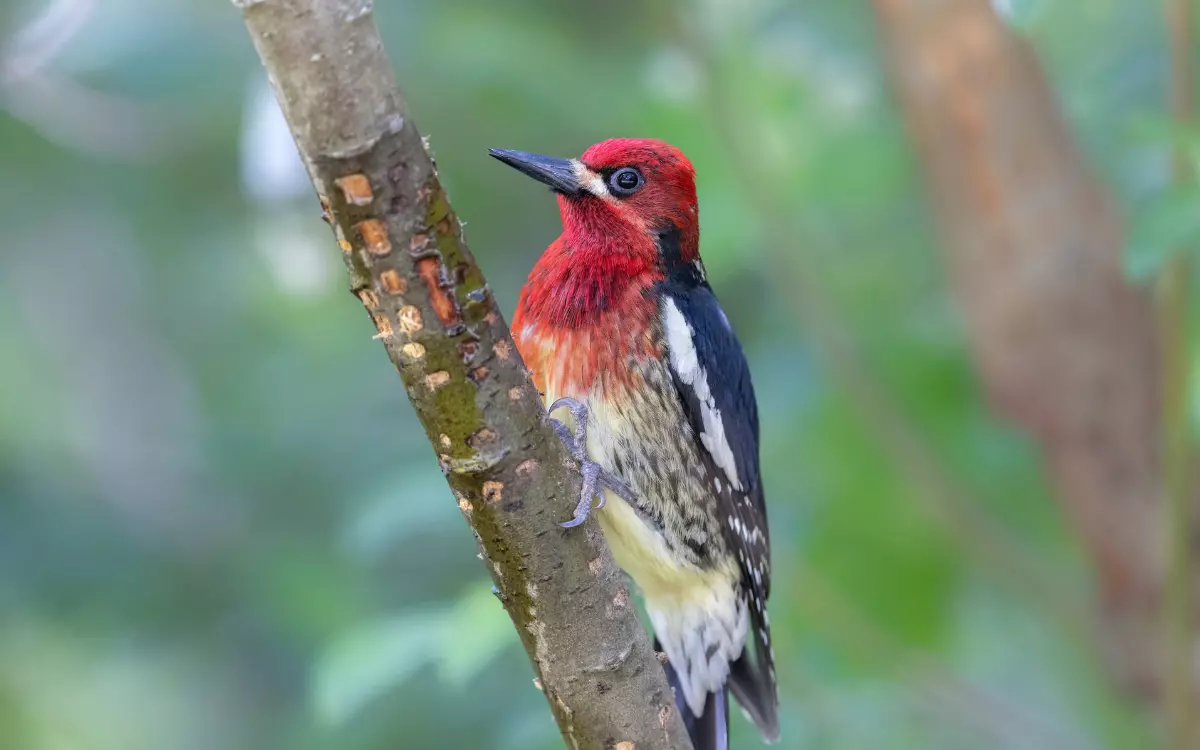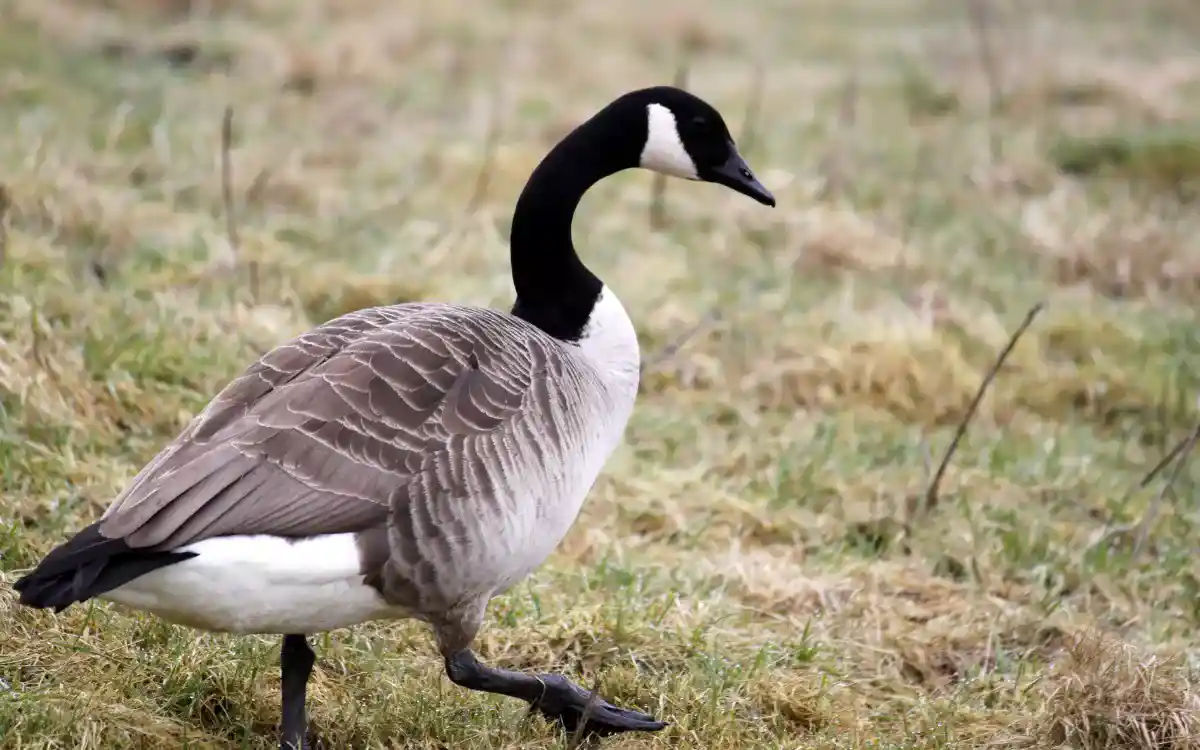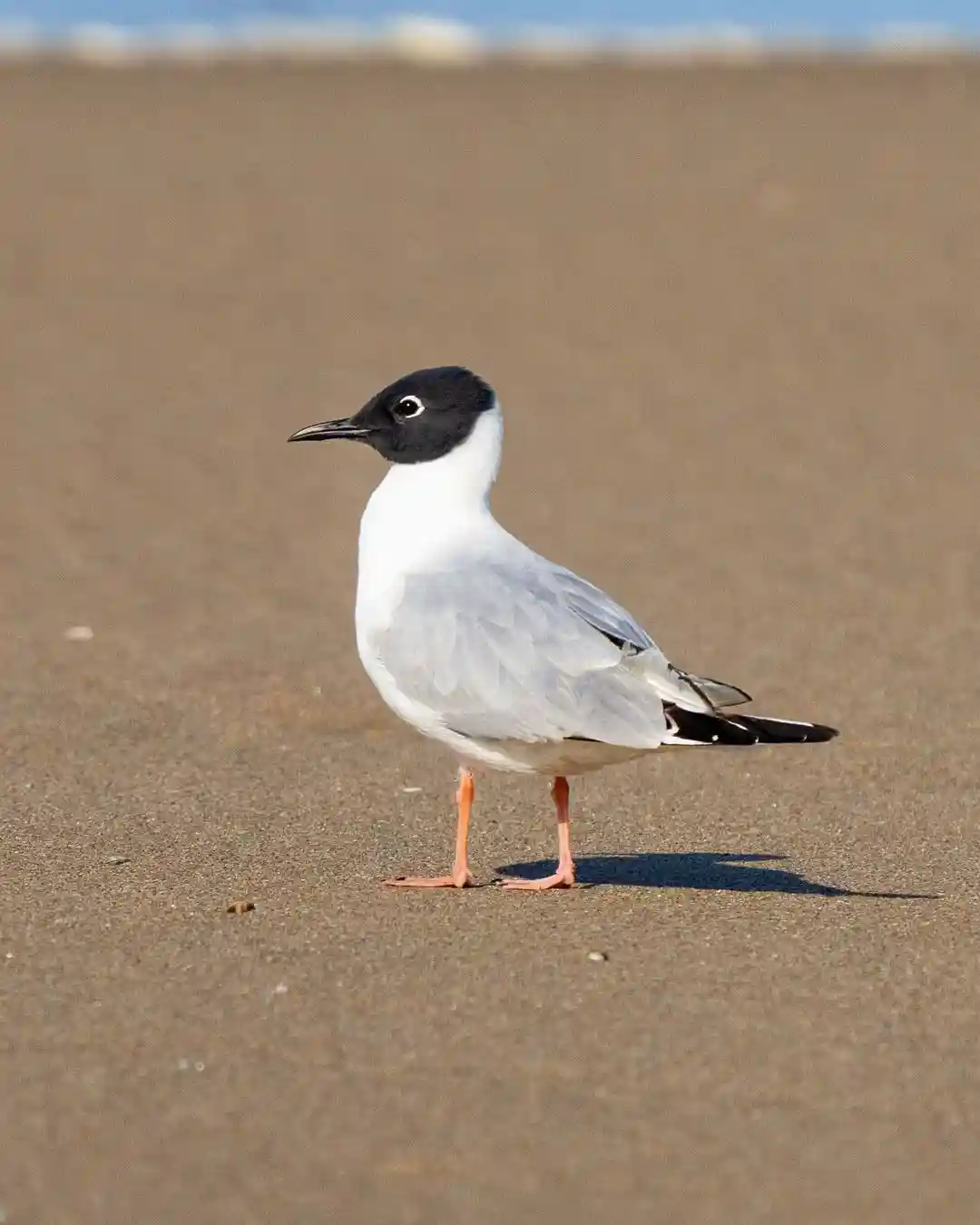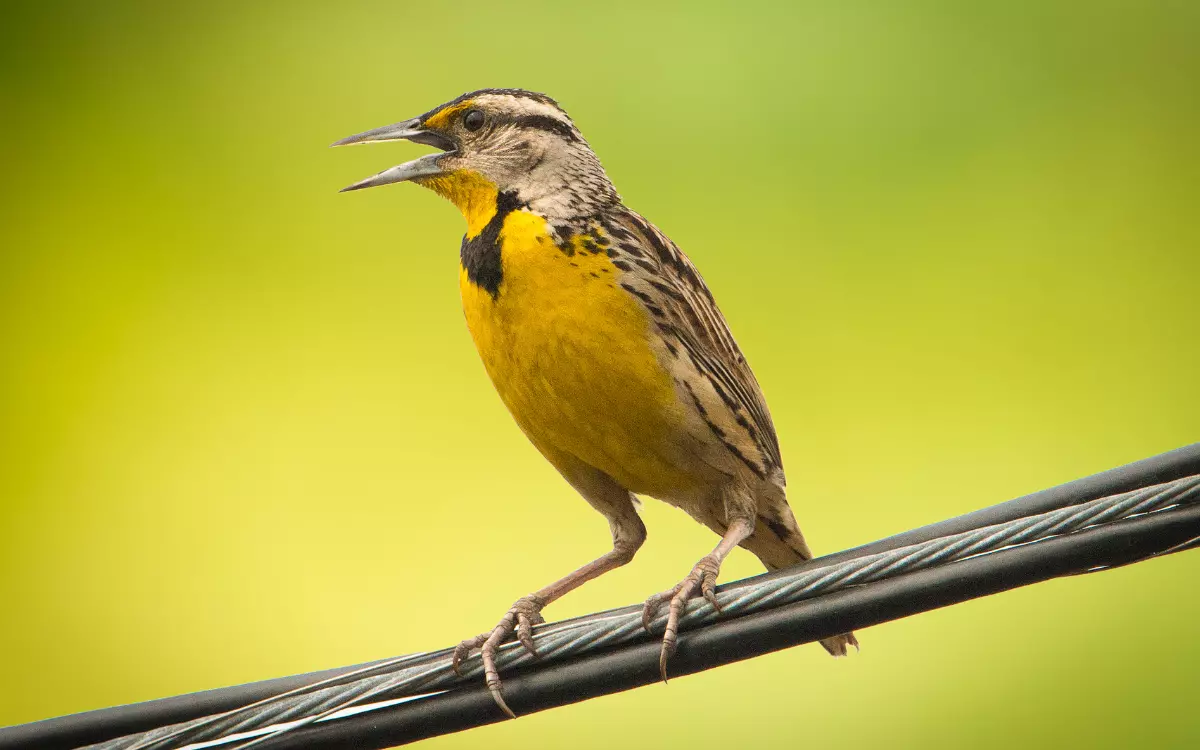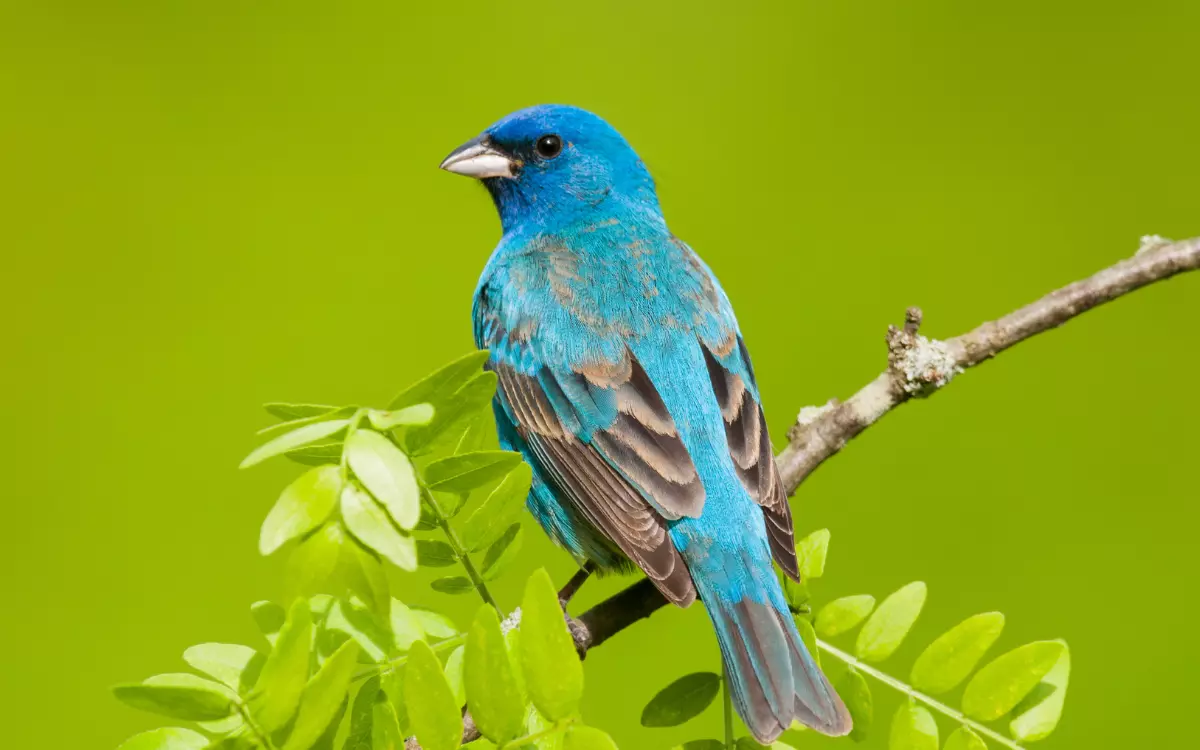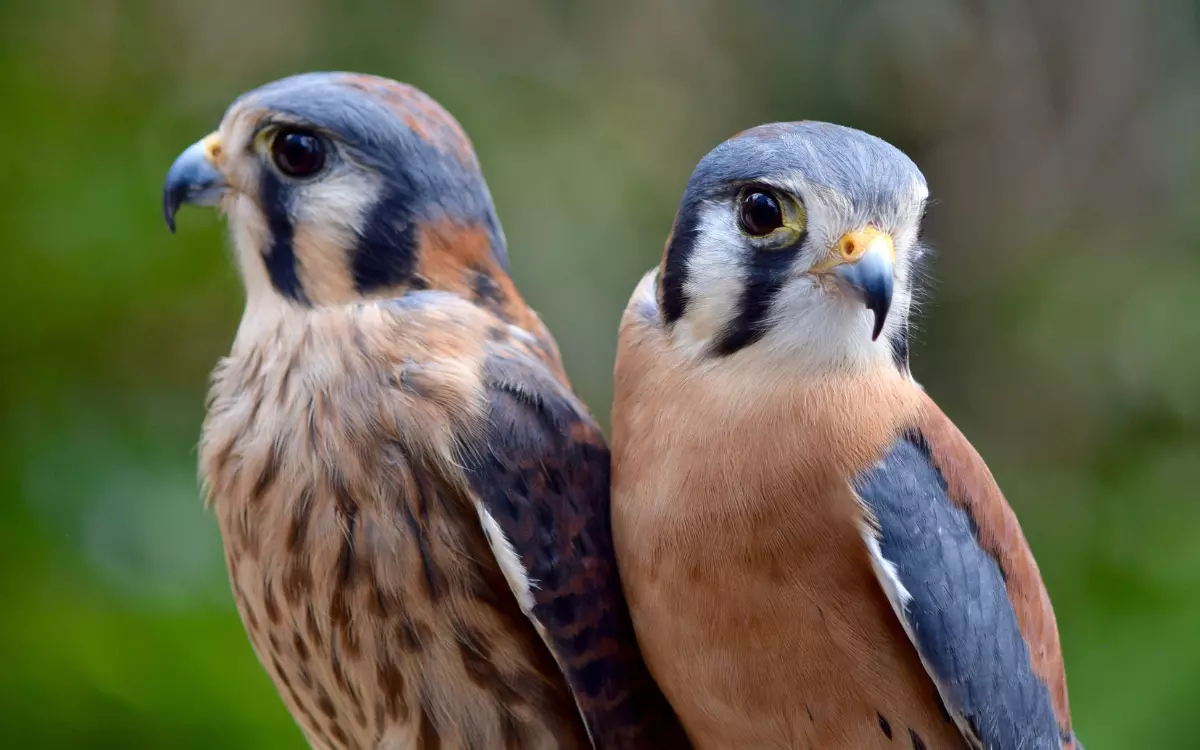Red, Orange & Yellow Birds of West Virginia
Red, Orange & Yellow Birds of West Virginia are dynamic and sprinkle against the state’s lush landscapes. Uncover these colorful birds, their habitats, and birdwatching tips for a spectacular viewing experience.
List of 9 Red, Orange & Yellow Birds of West Virginia
1.House Finch -( Haemorhous mexicanus):
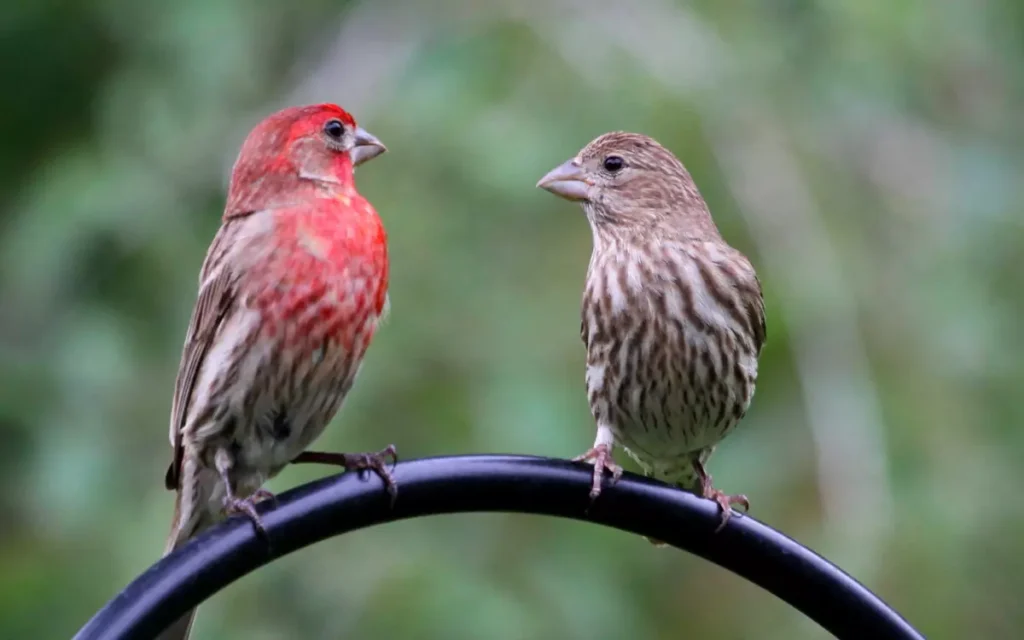
The House Finch, known by its scientific name Haemorhous mexicanus, is a common sight in West Virginia’s backyard. These adaptable birds are known for their cheerful chirps and stunning red plumage.
During breeding season, House Finches build their nests in a variety of locations, including hanging planters, eaves, and tree branches.
A typical clutch consists of 2 to 6 eggs, and the incubation period lasts about 12 to 14 days. After hatching, the chicks remain in the nest for an additional 12 to 19 days before fledging.
- Length: 5-6 in(12.5 – 15cm)
- Weight: 0.6-0.9 oz (16-27 gm)
- Wingspan: 8 -10 in (20 – 25 cm)
2. Purple Finch -( Haemorhous purpureus):
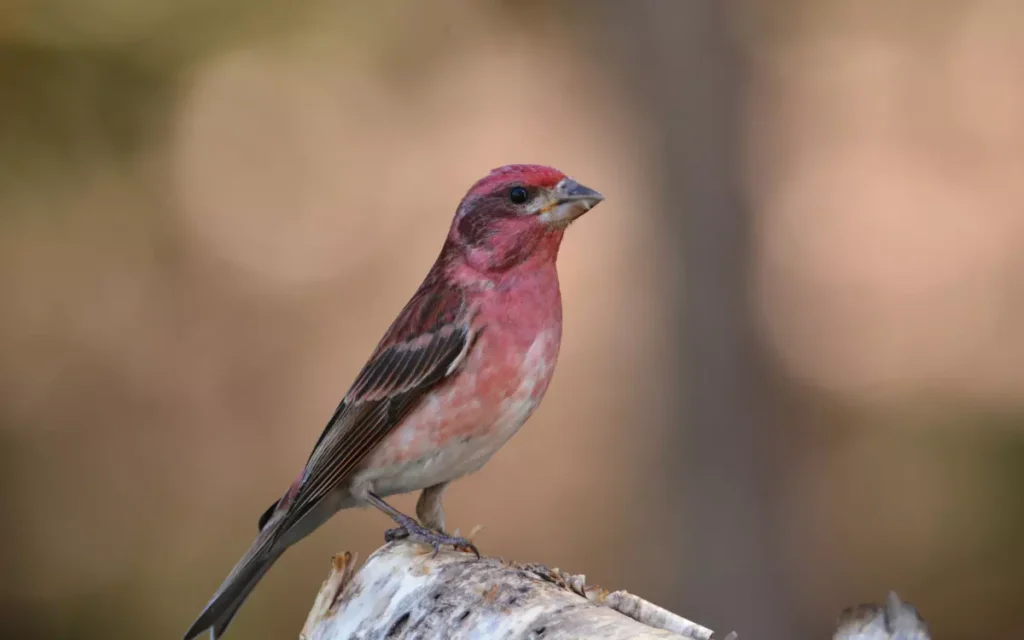
The Purple Finch, scientifically known as Haemorhous purpureus, is another red-hued visitor to West Virginia. These finches are known for their sweet, melodic songs that add a musical touch to the environment.
They prefer to nest in coniferous trees, crafting their nests from twigs, grass, and feathers. Purple Finches usually lay a clutch of 2 to 5 eggs, and the incubation period lasts approximately 12 to 14 days.
The young birds then spend around 12 to 19 days in the nest before venturing out on their own.
- Length: 4.7–6.3 in (12–16 cm)
- Weight: 0.63–1.13 oz (18–32 g)
- Wingspan: 10 in (25.4 cm)
3.Common Redpoll -(Acanthis flammea):
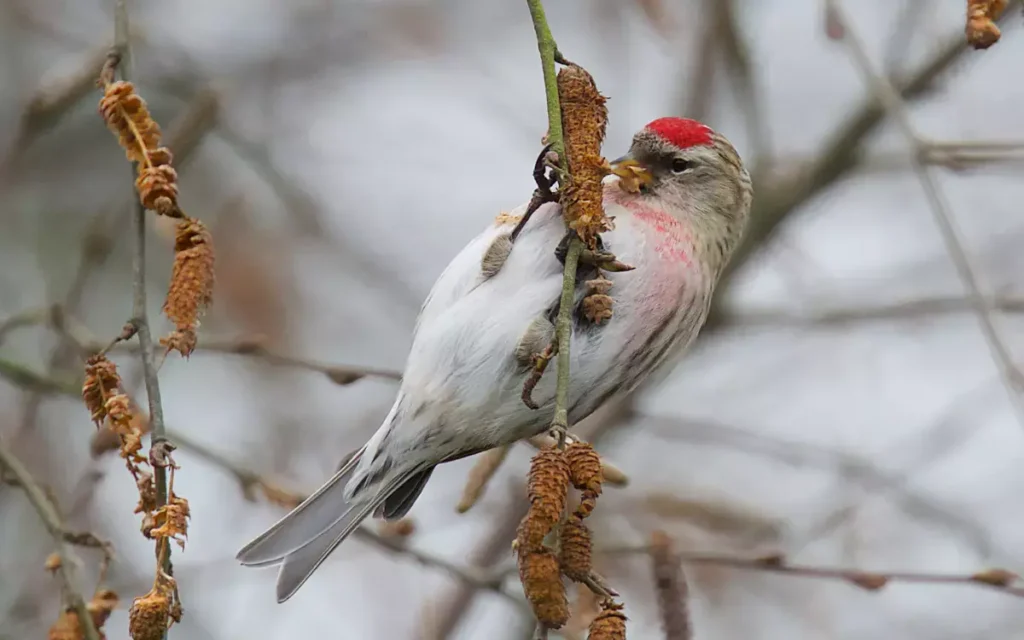
The Common Redpoll, scientifically known as Acanthis flammea, is a delightful winter visitor to West Virginia.
These small birds are known for their resilience in cold climates and are often spotted in flocks. Common Redpolls build their nests in shrubs and trees, typically laying around 4 to 6 eggs.
The incubation period for these eggs is about 10 to 16 days, with fledglings leaving the nest after approximately 14 to 18 days.
- Length: 4.5 – 5.5 in (11.5 – 14 cm )
- Weight: 0.42 – 0.56 oz (12 – 16 gm)
- Wingspan: 7.5 – 8.7 in (19 – 22 cm)
4.Red Crossbill -( Loxia curvirostra):
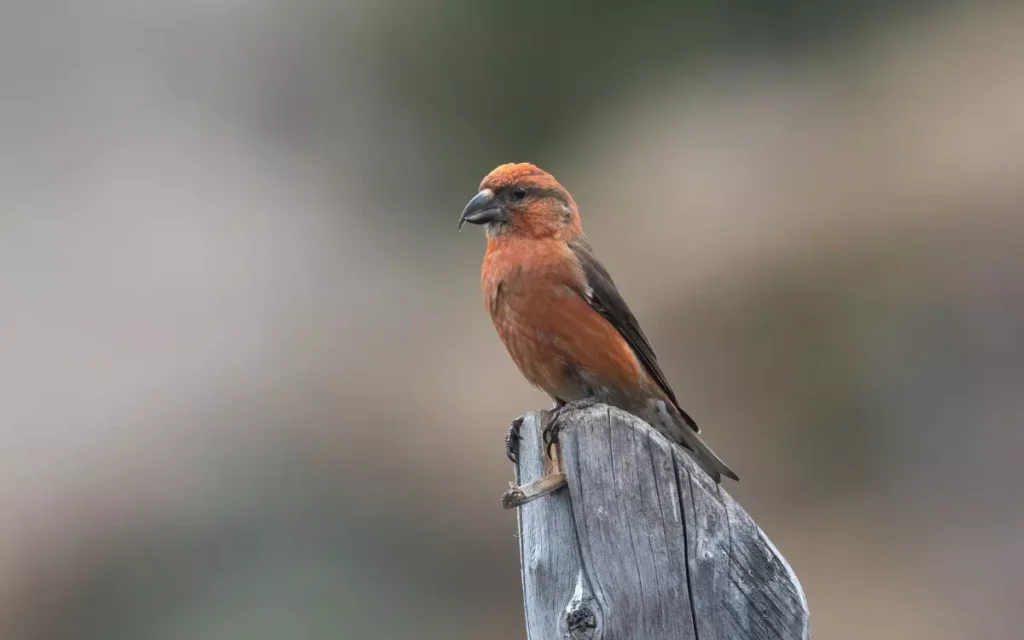
The Red Crossbill, scientifically known as Loxia curvirostra, ique bird with its distinctive crossed bill. This bill adaptation allows them to pry open conifer cones and extra3.ct seeds a primary food source for these birds.
They build their nests in coniferous trees, and their eggs usually number 3 to 4. The incubation period is approximately 12 to 16 days, followed by a fledging period of 16 to 22 days.
- Length: 7.87 in (20 cm)
- Weight: 1.41 – 1.86 oz (40-53 gm)
- Wingspan: 10.62 – 11.41 in ( 27–29 cm)
5. White-winged Crossbill – (Loxia leucoptera):
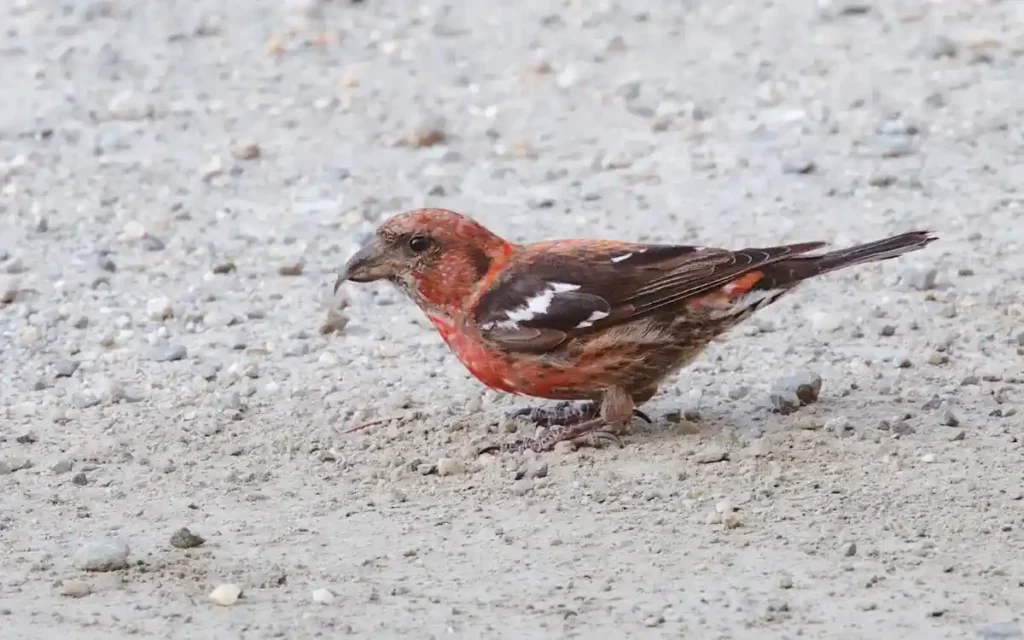
The White-winged Crossbill, scientifically known as Loxia leucoptera, is another member of the crossbill family. These birds are known for their nomadic behavior, moving to areas where coniferous cone crops are abundant.
They build their nests in coniferous trees and shrubs, typically laying 2 to 4 eggs. The incubation period is approximately 12 to 13 days, and the fledgling period lasts around 18 days.
- Length: 5.9-6.7 in (15-17 cm)
- Weight: 0.8-0.9 oz (24-26 gm)
- Wingspan: 10.2-11.0 in (26-28 cm)
6.Pine Grosbeak – (Pinicola enucleator):
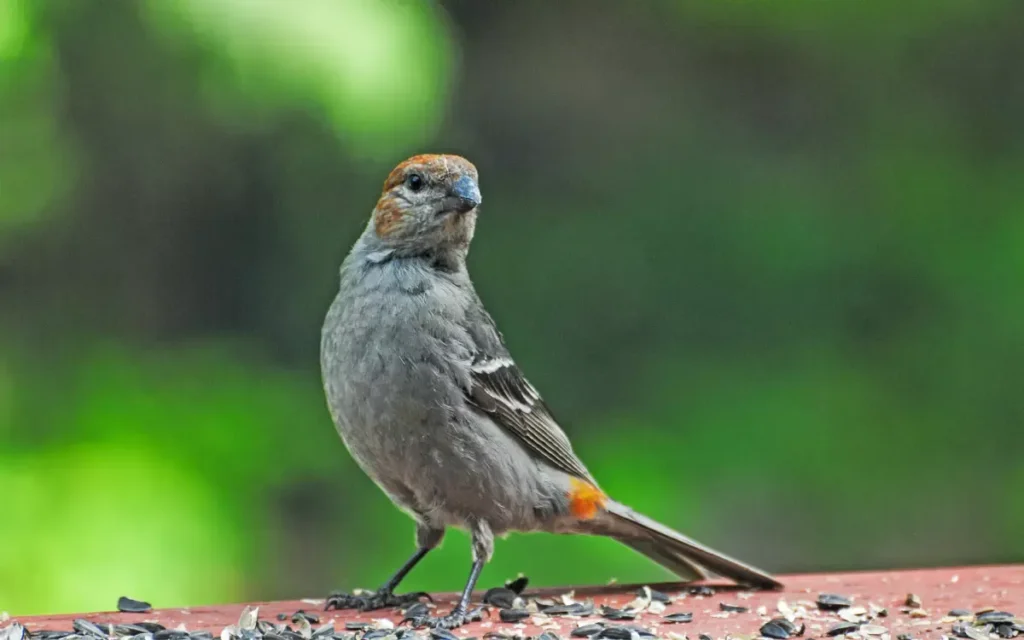
The Pine Grosbeak, scientifically known as Pinicola enucleator, is a striking bird that adds a touch of elegance to West Virginia’s avian diversity. These birds are known for their preference for boreal forests and open woodlands.
They build their nests in trees, typically laying 3 to 5 eggs. The incubation period lasts about 13 to 16 days, followed by a fledgling period of 15 to 19 days.
- Length: 7.9 – 10.0 in ( 20 – 25.5 cm )
- Weight: 1.8 – 2.8 oz ( 52 – 78 gm )
- Wingspan: 13.0 in (33 cm)
7.Northern Cardinal – (Cardinalis cardinalis):
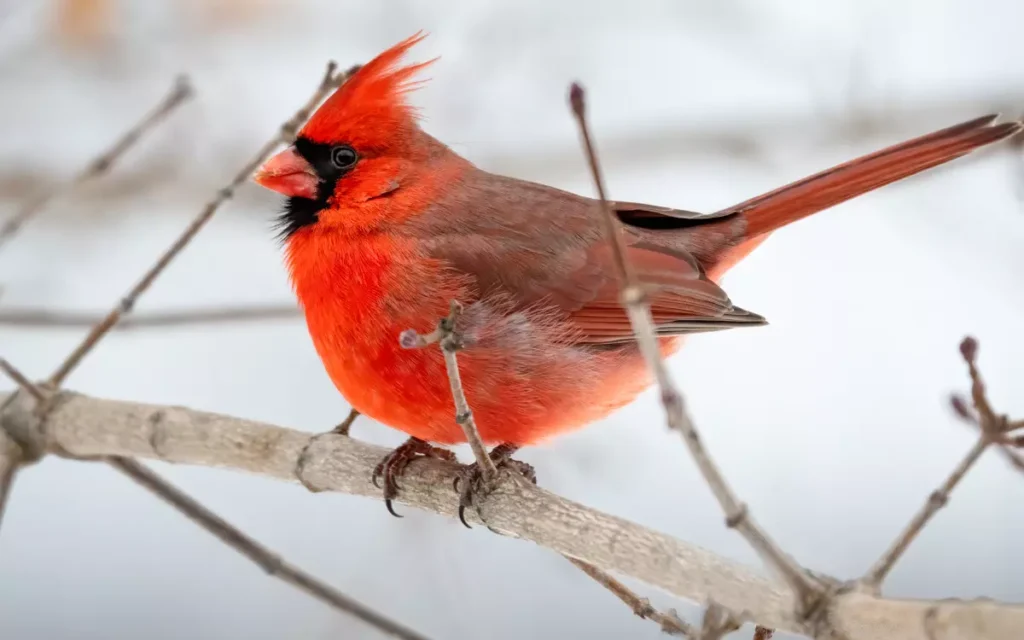
The Northern Cardinal, known by its scientific name Cardinalis cardinalis, is perhaps one of the most iconic red birds in North America. Its vivid plumage and distinctive crest make it easily recognizable.
Cardinals are known for their strong songs and territorial behavior. They build cup-shaped nests in shrubs and trees, usually laying 2 to 5 eggs.
The incubation period lasts around 11 to 13 days, and the young birds spend about 9 to 11 days in the nest before taking flight.
- Length: 8.3–9.3 in (21–23.5 cm)
- Weight: 1.19–2.29 oz (33.6–65 gm)
- Wingspan: 9.8–12.2 in (25–31 cm).
8. Painted Bunting – (Passerina ciris):
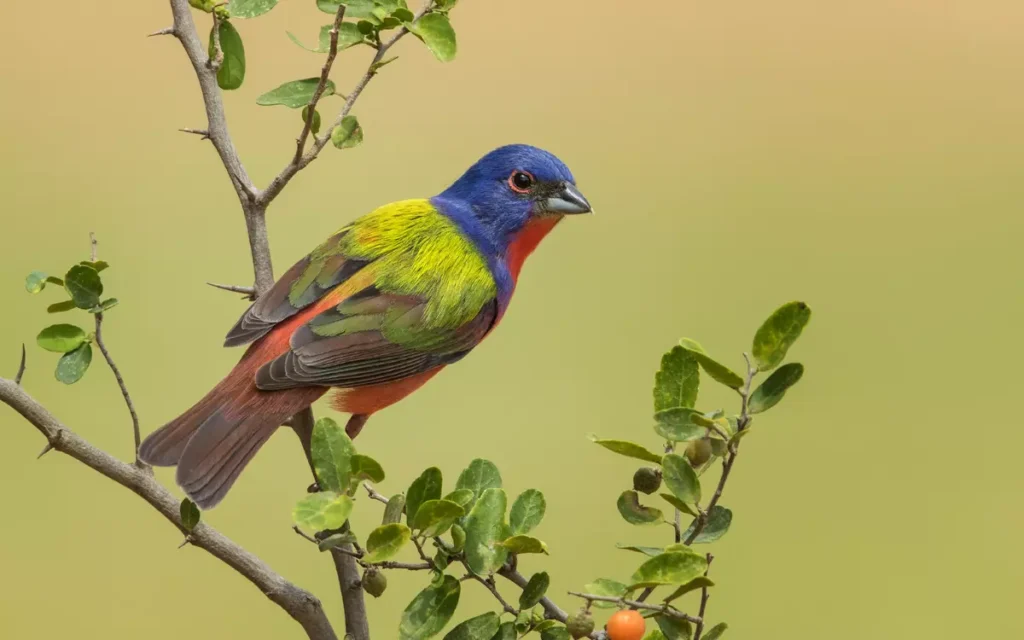
The Painted Bunting, scientifically known as Passerina ciris, is a true gem among red birds. These brilliantly colored birds are a sight to behold, with males exhibiting a stunning combination of red, blue, and green hues.
Painted Buntings build their nests in dense shrubs and bushes, typically laying 3 to 4 eggs.The incubation period lasts about 11 to 12 days, followed by a fledgling period of 10 to 12 days.
- Length: 4.7–5.5 in (12–14 cm),
- Weight: 0.46–0.67 oz(13–19 gm )
- Wingspan: 8.3–9.1 in ( 21–23 cm)
9.Scarlet Tanager -( Piranga olivacea):
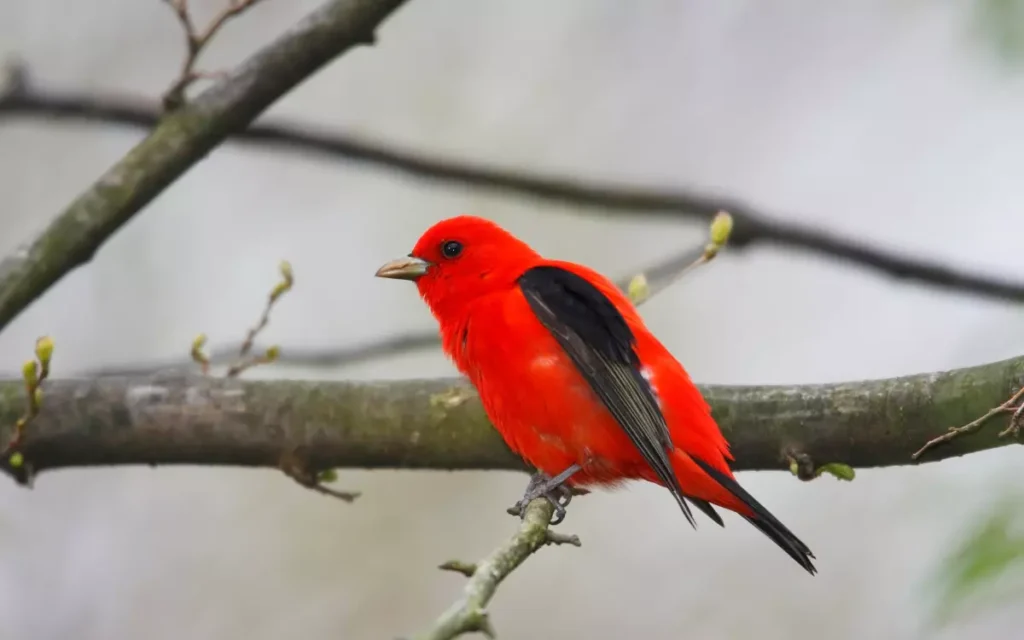
The Scarlet Tanager, scientifically known as Piranga olivacea, is a true harbinger of summer with its vibrant red plumage. These birds are known for their unique feeding habits, often catching insects mid-flight.
Scarlet Tanagers build their nests in deciduous trees, laying around 3 to 5 eggs. The incubation period lasts about 12 to 14 days, and the fledgling period is approximately 9 to 12 days.
- Length: 6.3-6.7 in (16-17 cm)
- Weight: 0.8-1.3 oz (23-38 g)
- Wingspan: 9.8-11.4 in (25-29 cm)
Read also: 8 White Birds In West Virginia (ID & INFO)
8 Orange Birds of West Virginia:
1. Eastern Towhee (Pipilo erythrophthalmus):
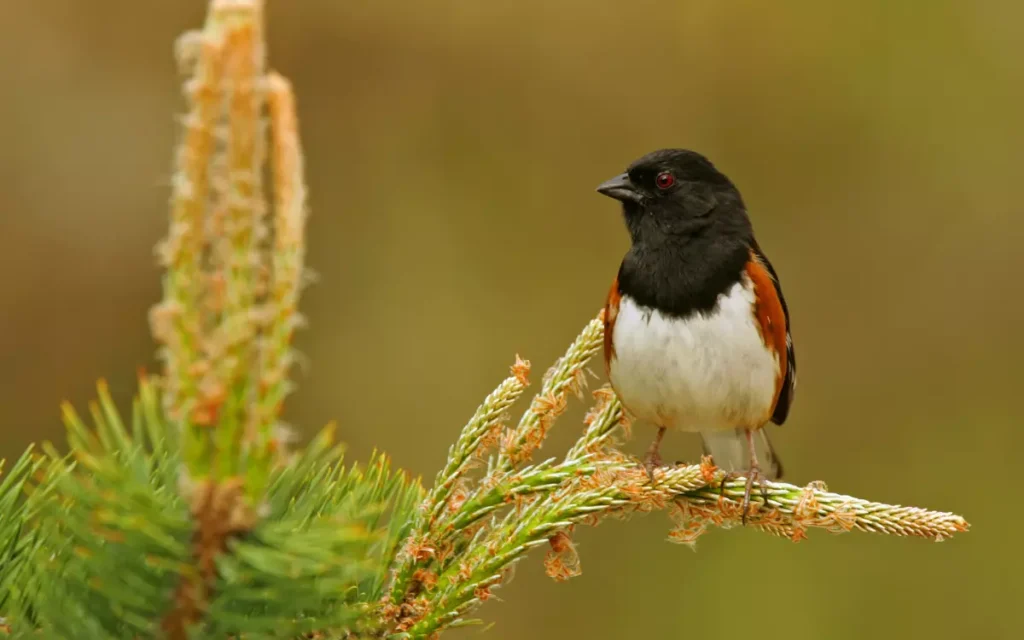
The Eastern Towhee, characterized by its striking orange-brown sides and jet-black upper body, is a captivating sight in West Virginia. This sparrow-sized bird prefers shrubby habitats and often forages on the ground for insects and seeds.
It lays 2-6 eggs in a well-hidden nest, with both parents taking part in incubation. Spending much of its time in the region throughout the year, the Eastern Towhee’s distinctive “drink-your-tea” call echoes through the woodlands.
- Length: 6.8-8.2 in (17.3-20.8 cm)
- Weight: 1.1-1.8 oz (32-52 g)
- Wingspan: 7.9-11.0 in (20-28 cm)
2. American Redstart (Setophaga ruticilla):
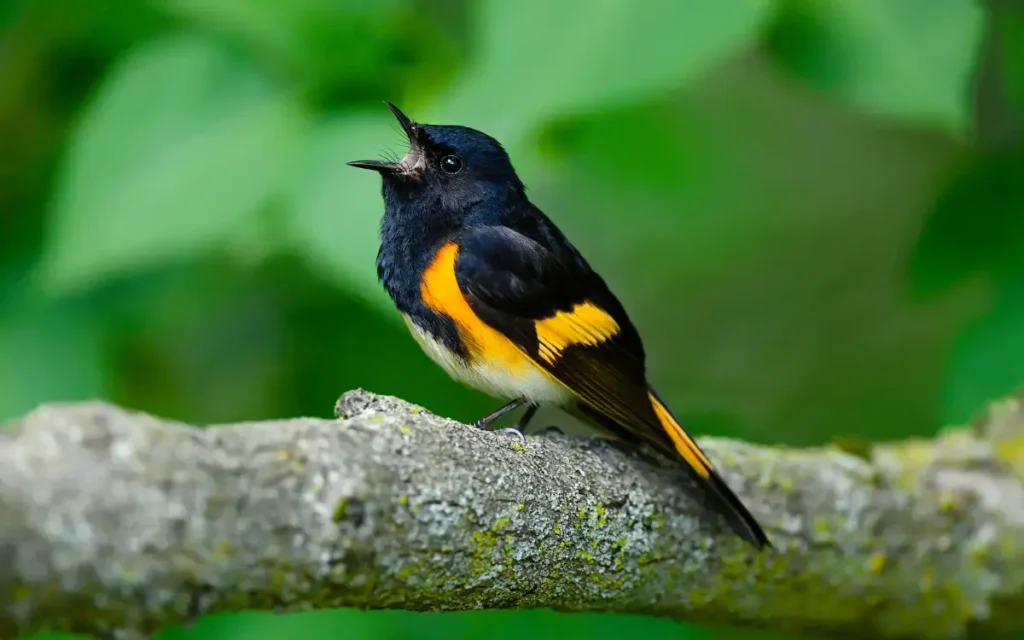
The American Redstart, a warbler with bright orange patches on its tail and sides, is a migratory wonder in West Virginia. Its unique coloration is especially prominent during its active feeding displays.
These birds are known for their agility as they catch insects mid-air. In West Virginia, they breed during the summer, laying around 3-5 eggs per nest. Their presence is a testament to the region’s ecological divers
- Length: 4.3-5.1 in (11-13 cm)
- Weight: 0.2-0.3 oz (6-9 g)
- Wingspan: 6.3-7.5 in (16-19 cm)
3. Barn Swallow (Hirundo rustica):
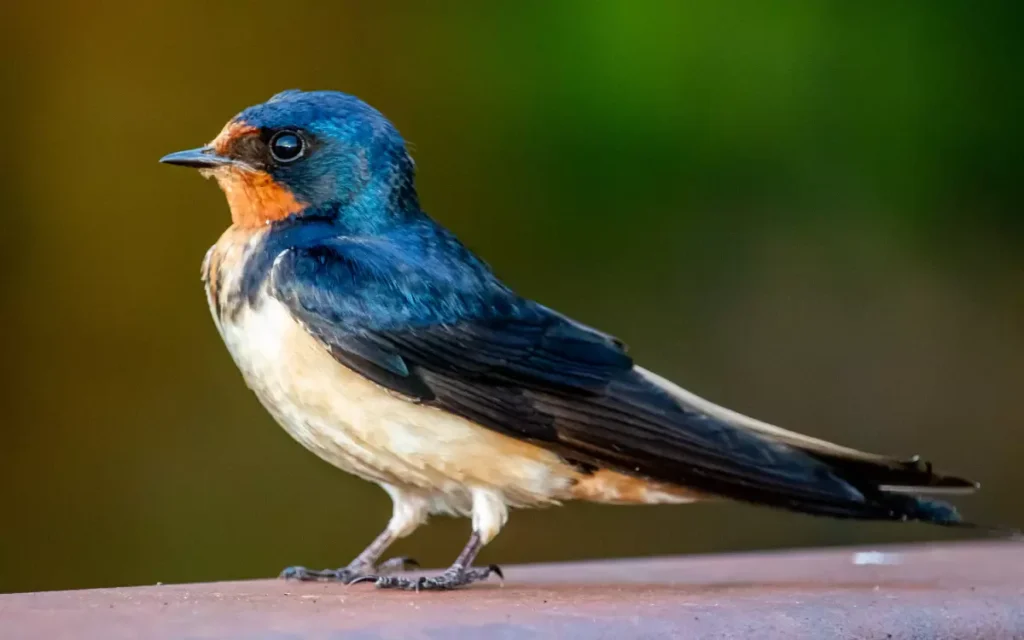
The Barn Swallow boasts a rusty-orange throat and forehead, contrasting with its deep blue upperparts. A symbol of summer, these birds are skilled aerialists, darting through the skies to catch flying insects.
They construct cup-shaped nests in barns or similar structures, where they lay 3-7 eggs. These migratory birds spend their summers in West Virginia, filling the air with their graceful flight patterns.
- Length: 5.9-7.5 in (15-19 cm)
- Weight: 0.6-0.7 oz (17-20 g)
- Wingspan: 11.4-12.6 in (29-32 cm)
4. Red-shouldered Hawk (Buteo lineatus):
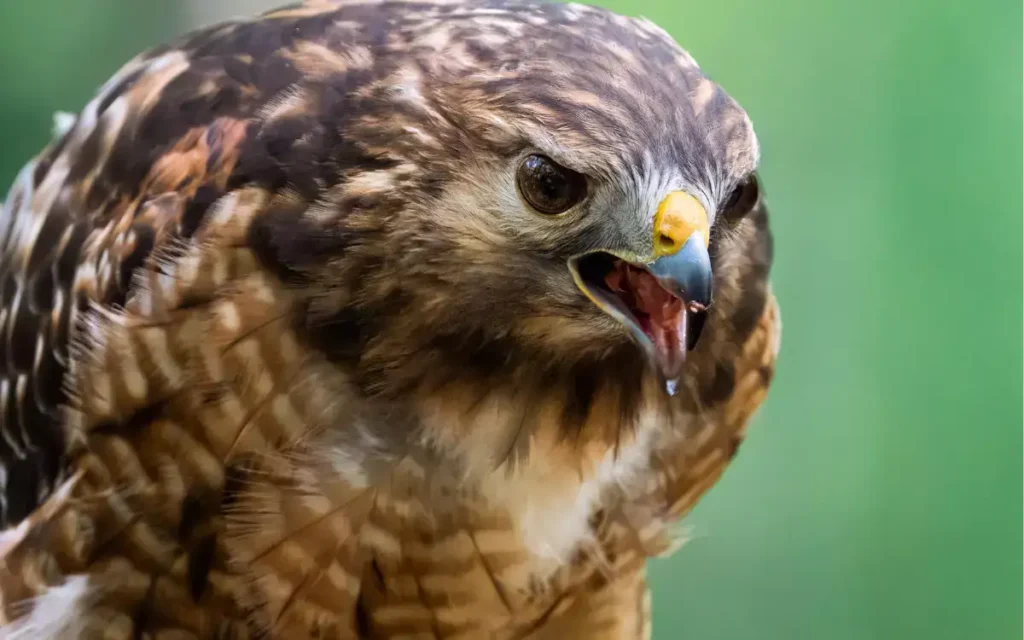
While not entirely orange, the Red-shouldered Hawk exhibits striking warm tones on its underparts.
This raptor is a year-round resident in West Virginia’s forests, emitting its distinctive, high-pitched call. With a preference for wooded areas near water, they lay 2-4 eggs in a nest high in the trees.
- Length: 16.9-24.0 in (43-61 cm)
- Weight: 17.1-27.3 oz (486-774 g)
- Wingspan: 37.0-43.7 in (94-111 cm)
5. Brown Thrasher (Toxostoma rufum):
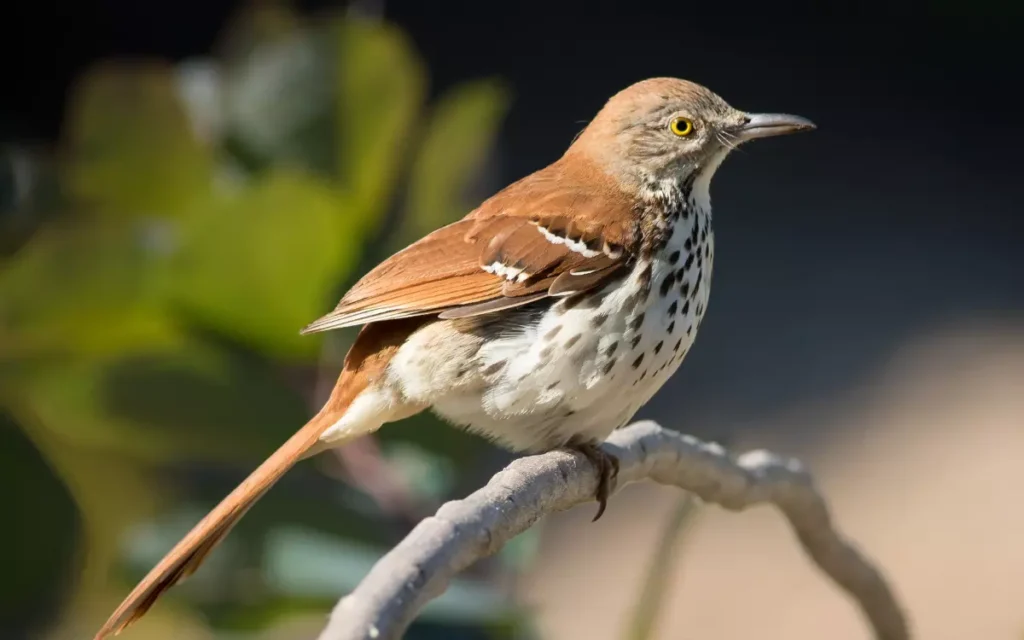
The Brown Thrasher showcases a rich reddish-brown hue, and though not exclusively orange, its coloration stands out. Known for their melodious songs, these birds are often found in dense vegetation.
They nest on the ground, laying 3-5 eggs, and their residency in West Virginia adds a delightful auditory and visual dimension to the local ecosystem.
- Length: 9.3 – 12.0 in ( 23.5 – 30.5 cm )
- Weight: 2.2 – 3.1 oz ( 61 – 89 gm)
- Wingspan: 11 – 13 in (29 – 33 cm)
6. Baltimore Oriole (Icterus galbula):
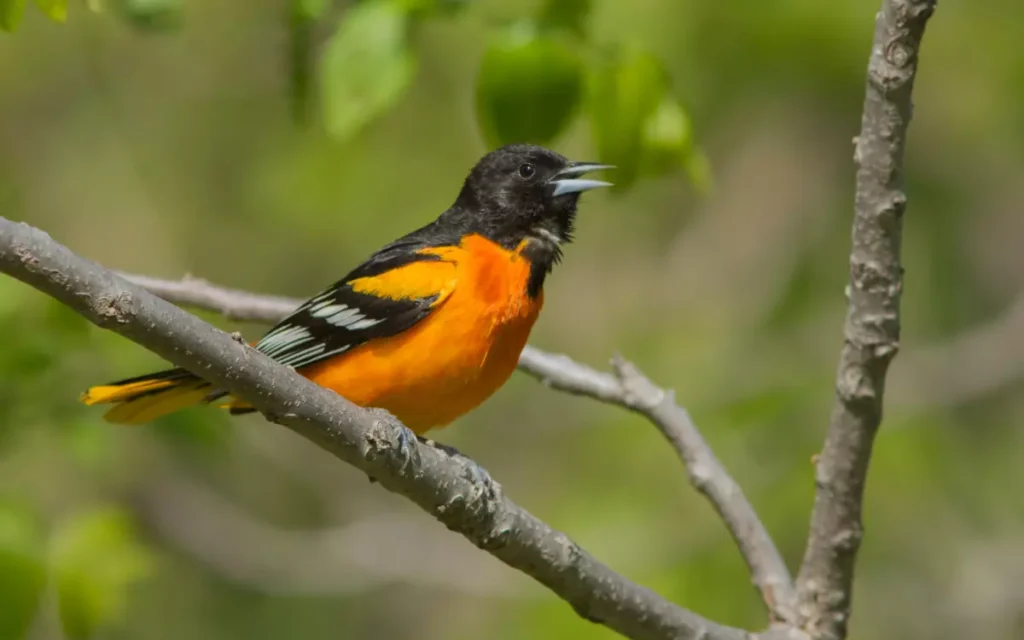
The Baltimore Oriole’s brilliant orange plumage evokes the warmth of the tropics. Migrating to West Virginia during the summer, these birds weave pendant-shaped nests high in trees, where they lay 3-7 eggs.
Their distinct song and vibrant appearance make them a cherished sighting for bird enthusiasts in the region.
- Length: 6.7–8.7 in (17–22 cm)
- Weight: 0.79 – 1.48 oz ( (22.3 – 42 gm )
- Wingspan: 9.1–12.6 in ( 23–32 cm)
7. Orchard Oriole (Icterus spurius):
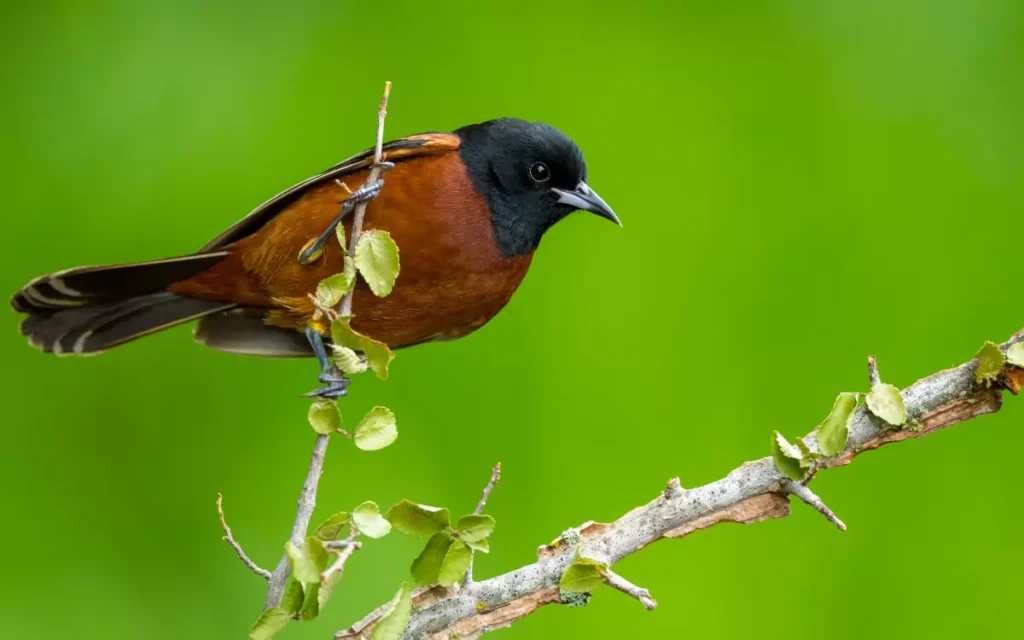
The Orchard Oriole, with its mix of russet and black, is another orange-hued visitor to West Virginia. These birds frequent open woodlands and orchards, weaving their pouch-like nests in shrubs or trees.
They lay around 3-5 eggs and are known for their sweet, whistling songs during their stay in the state.
- Length: 5.9-7.1 in (15-18 cm)
- Weight: 0.6-1.0 oz (16-28 g)
- Wingspan: 9.8 in (25 cm)
8. American Kestrel (Falco sparverius):
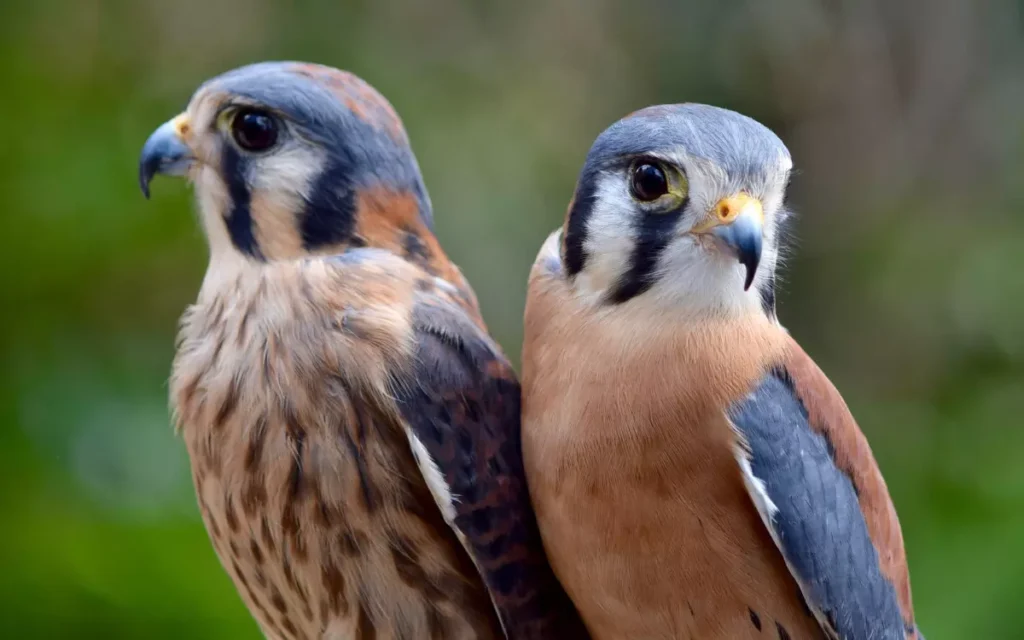
The American Kestrel, with its rusty-colored back and tail, is the smallest falcon in North America. Often seen perched on wires or hunting from a hover, these birds are year-round residents in West Virginia.
They nest in tree cavities or man-made structures, laying a clutch of eggs. Their striking appearance and hunting prowess make them a remarkable part of the local avian landscape.
- Length: 8.7 -12.2 in (22-31 cm)
- Weight: 3 – 6 oz (85.04 – 170 gm)
- Wingspan: 20–24 in (51–61 cm )
Read also: 49 Red, Orange, and Yellow Birds in Louisiana
20 Yellow Birds of West Virginia:
Yellow—the colour of sunshine, happiness, and warmth. It’s a hue that stands out in the avian world, painting the skies with vibrant strokes. In West Virginia, a state known for its natural beauty, yellow birds add a touch of brilliance to the landscape.
1. Yellow-headed Blackbird – Xanthocephalus xanthocephalus:
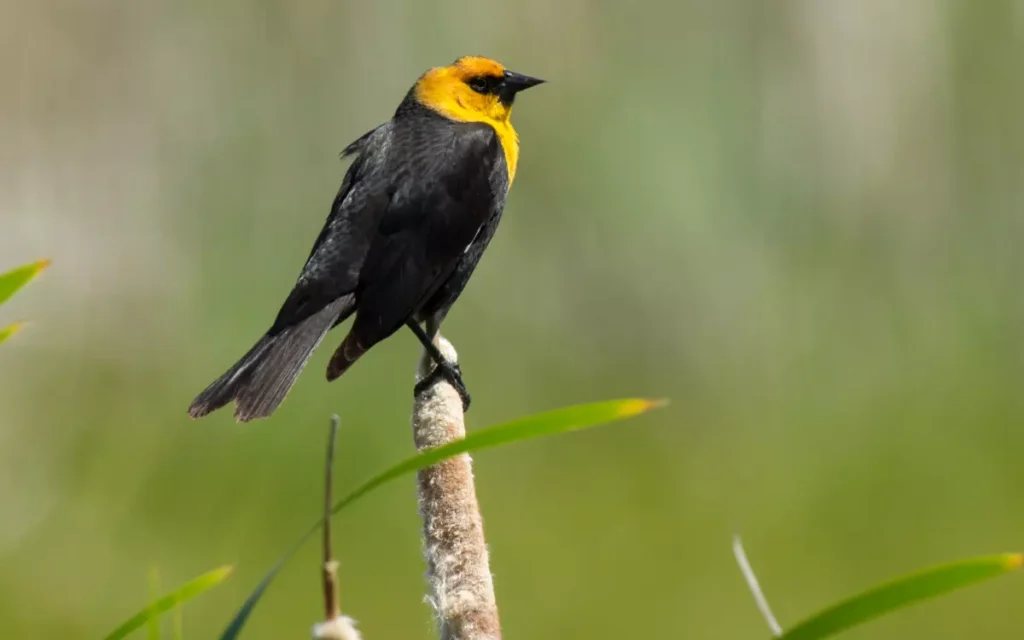
Amidst the verdant landscapes of West Virginia, the Yellow-headed Blackbird reigns as a bold symbol of contrast. With its sleek black plumage and striking yellow head, it commands attention.
This bird is known for its gregarious nature, often gathering in large flocks in marshes and wetlands. Nesting in colonies, females lay around 3 to 4 eggs, which they diligently care for until hatching.
- Length: 8.3-10.2 in (21-26 cm)
- Weight: 1.6-3.5 oz (44-100 g)
- Wingspan: 16.5-17.3 in (42-44 cm)
2.Dickcissel – Spiza americana:
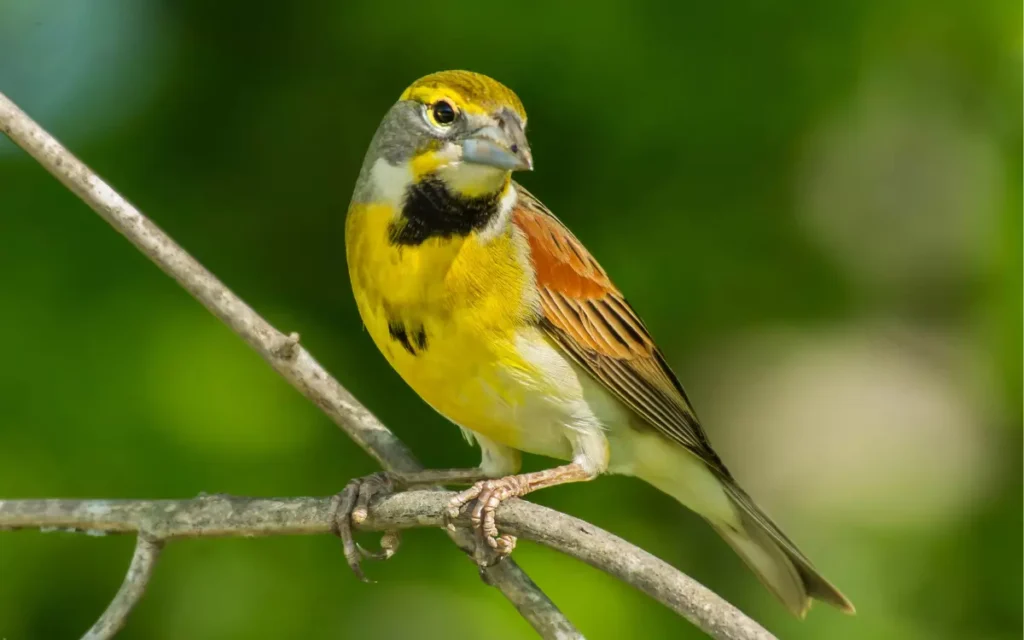
Meet the Dickcissel, a songbird that serenades the meadows and grasslands of West Virginia with its distinctive song.
Its olive-yellow plumage with streaks of black makes it a sight to behold. These birds are often found in agricultural areas and open fields.
In the breeding season, females lay approximately 3 to 5 eggs in cup-shaped nests. Throughout the year, they remain a charming presence, enriching the state’s avian diversity.
- Length: 5.5-6.3 in (14-16 cm)
- Weight: 0.9-1.4 oz (25.6-38.4 g)
- Wingspan: 9.8-10.2 in (24.8-26 cm)
3. Wilson’s Warbler – Cardellina pasilla:
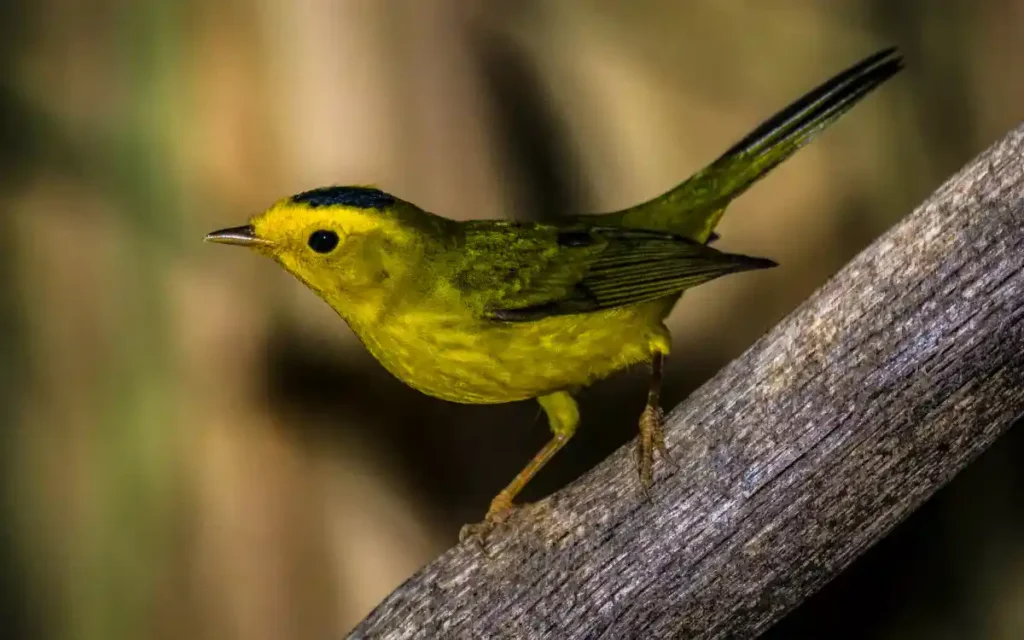
The Wilson’s Warbler is a petite wonder, characterized by its bright yellow underparts and distinctive black cap. These energetic birds are frequently spotted foraging among shrubs and foliage.
Female Wilson’s Warblers lay around 4 to 5 eggs in well-hidden nests, ensuring the survival of their species. With their animated movements and cheerful calls, they contribute to the lively tapestry of West Virginia’s birdlife.
- Length: 3.9-4.7 in (10-12 cm)
- Weight: 0.2-0.3 oz (5-10 g)
- Wingspan: 5.5-6.7 in (14-17 cm)
4. Prothonotary Warbler – Protonotaria citrea:
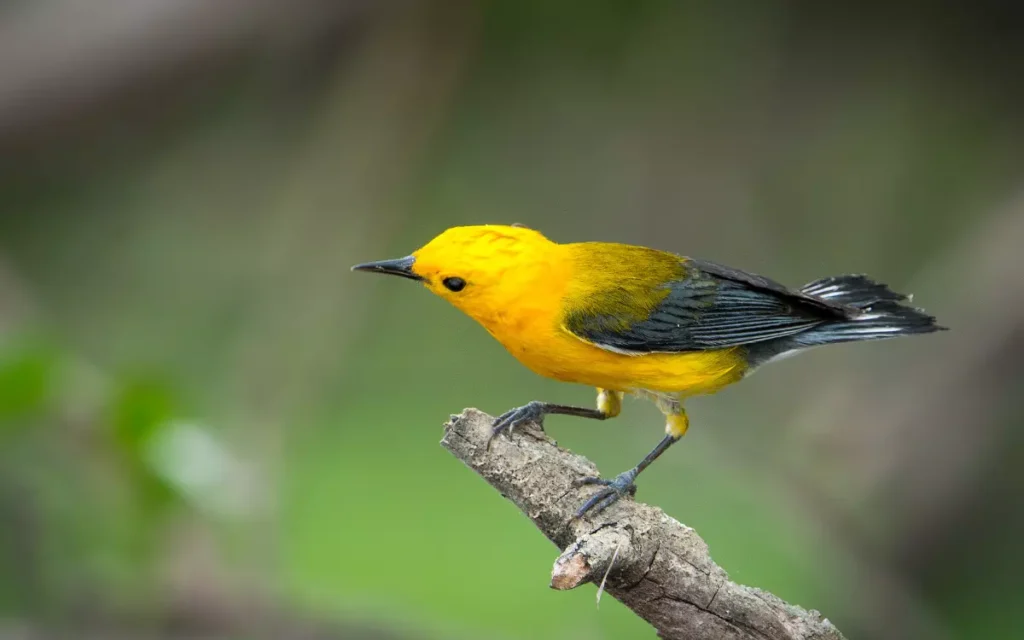
A bird that seems to carry the sun’s glow within its feathers, the Prothonotary Warbler is a dazzling presence in West Virginia. Its vibrant yellow plumage is impossible to miss as it flits among swamps and riverbanks.
Females of this species lay 4 to 7 eggs in nests tucked away in tree cavities or nesting boxes. Their appearance heralds the arrival of warmer months and brings a touch of radiance to the state’s waterways.
- Length: around 5.1 in (13 cm)
- Weight: 0.44 oz (12.5 g)
- Wingspan: 8.75 in (22 cm)
5.Evening Grosbeak – Coccothraustes vespertinus:
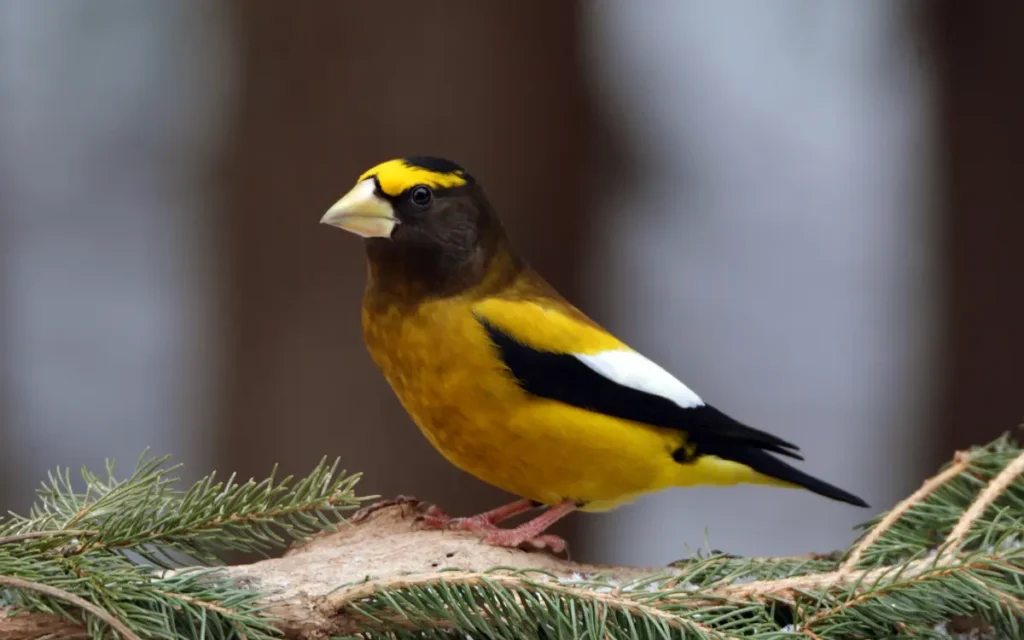
As the sun sets over the mountains of West Virginia, the Evening Grosbeak emerges with its distinctive blend of yellow and black plumage. These social birds often travel in flocks, foraging for seeds and fruits.
The nesting habits of the Evening Grosbeak are intriguing—females lay 2 to 4 eggs in open cup nests placed in conifer trees.
- Length: 16 to 22 cm (6.3 to 8.7 in)
- Weight: 38.7 to 86.1 g (1.37 to 3.04 oz)
- Wingspan: 30 to 36 cm (12 to 14 in)
6. Nashville Warbler – Leiothlypis ruficapilla:
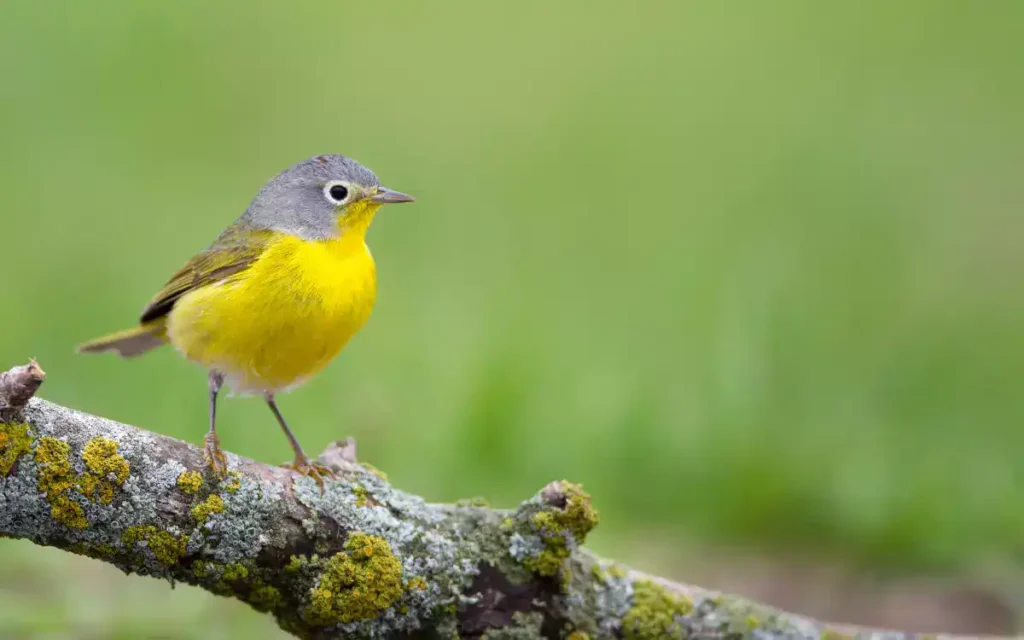
The Nashville Warbler is a lively songster that brightens up woodlands and forests with its yellow-green plumage. With a distinct white eye ring, it’s easily identifiable.
These birds are known for their migratory journeys, spending their breeding season in North America, including West Virginia. Females lay 4 to 5 eggs in cup nests, carefully hidden amidst foliage.
- Length: 4.3-5.1 in (11-13 cm)
- Weight: 0.2-0.5 oz (6.7-13.9 g)
- Wingspan: 6.7-7.9 in (17-20 cm)
7. Canada Warbler – Cardellina canadensis:
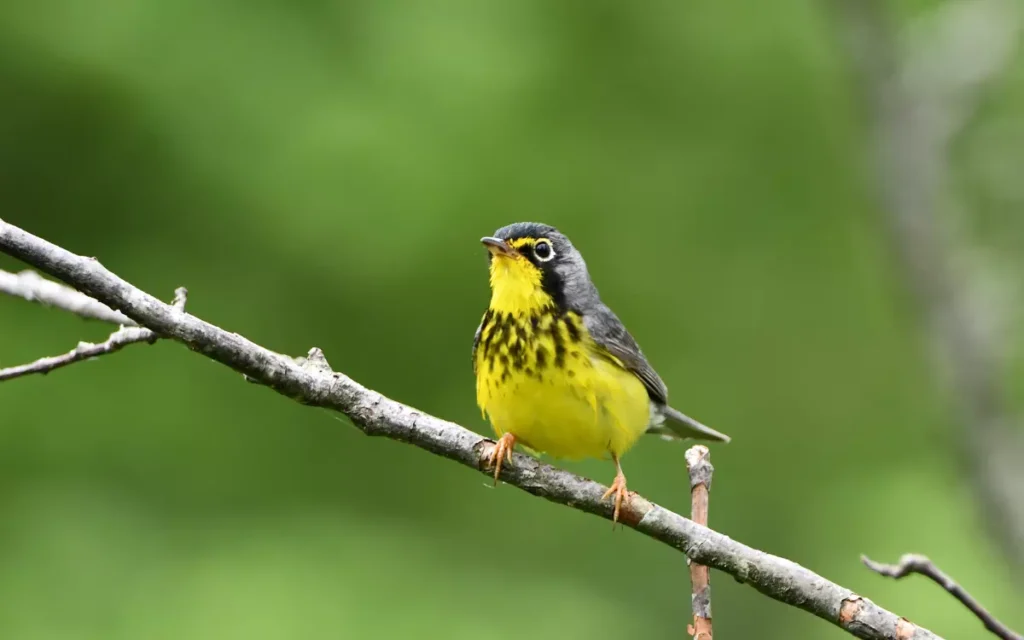
A bird that wears a “necklace” of gray feathers, the Canada Warbler is a charming visitor to West Virginia’s woodlands. Its bright yellow underparts contrast beautifully with the gray tones.
These birds are known for their modest nesting habits, often choosing low shrubs or ferns to build their nests. Females lay 4 to 5 eggs, contributing to the future generation of these delightful warblers.
- Length: 4.7-5.9 in (12-15 cm)
- Weight: 0.3-0.5 oz (9-13 g)
- Wingspan: 6.7-8.7 in (17-22 cm)
8. Prairie Warbler – Setophaga discolor:
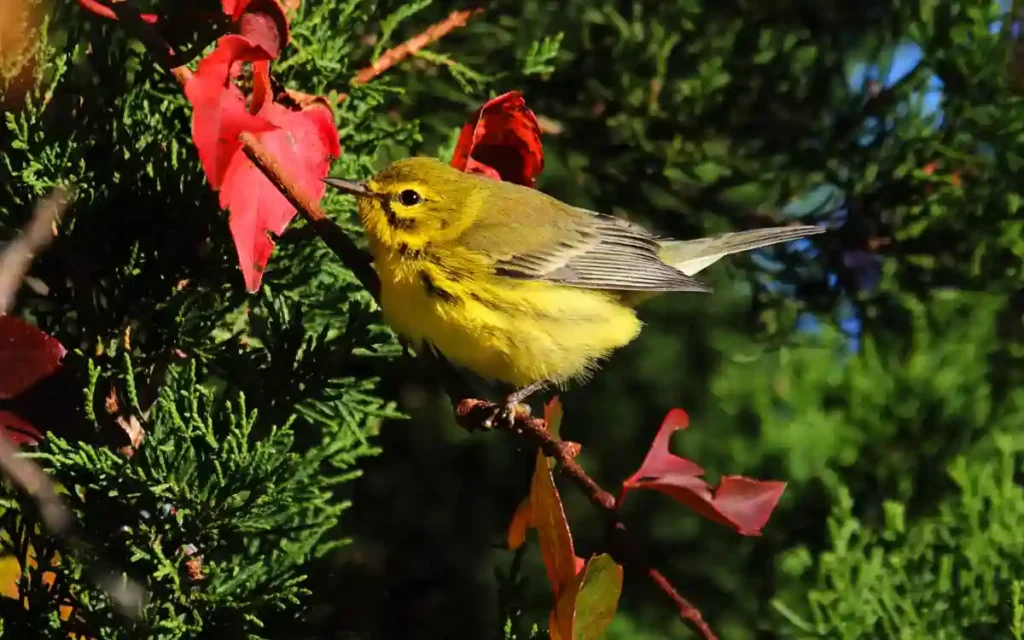
The Prairie Warbler is a lively sprite with a penchant for open areas, including grasslands and shrubby habitats. Its striking yellow plumage with black streaks makes it a visual treat.
Nesting low to the ground, females lay around 3 to 5 eggs in well-hidden nests. With their distinctive buzzing songs, Prairie Warblers add a layer of vibrancy to West Virginia’s avian symphony.
- Length: 4.3 in (11 cm)
- Weight: 0.2-0.3 oz (6.4-8.8 g)
- Wingspan: 7 in (17.78 cm)
9. Cape May Warbler – Setophaga tigrina:
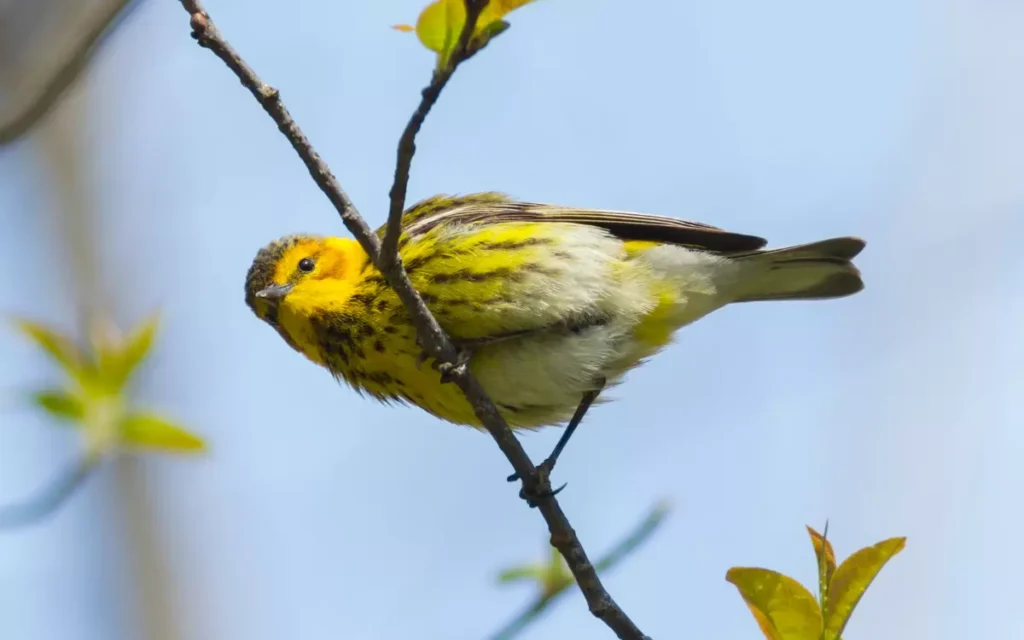
A glimpse of the Cape May Warbler is a treat for any bird enthusiast. This small songbird features a mix of yellow, olive, and chestnut hues, creating a captivating color palette.
Known for their nomadic tendencies, these warblers visit West Virginia during their migration. Female Cape May Warblers lay 4 to 5 eggs in coniferous trees, contributing to the diversity of the state’s bird population.
- Length: 4.7-5.1 in (12-13 cm)
- Weight: 0.4-0.5 oz (10.2-15.2 g)
- Wingspan: 7.9-8.7 in (20-22 cm)
10. Palm Warbler – Setophaga palmarum:
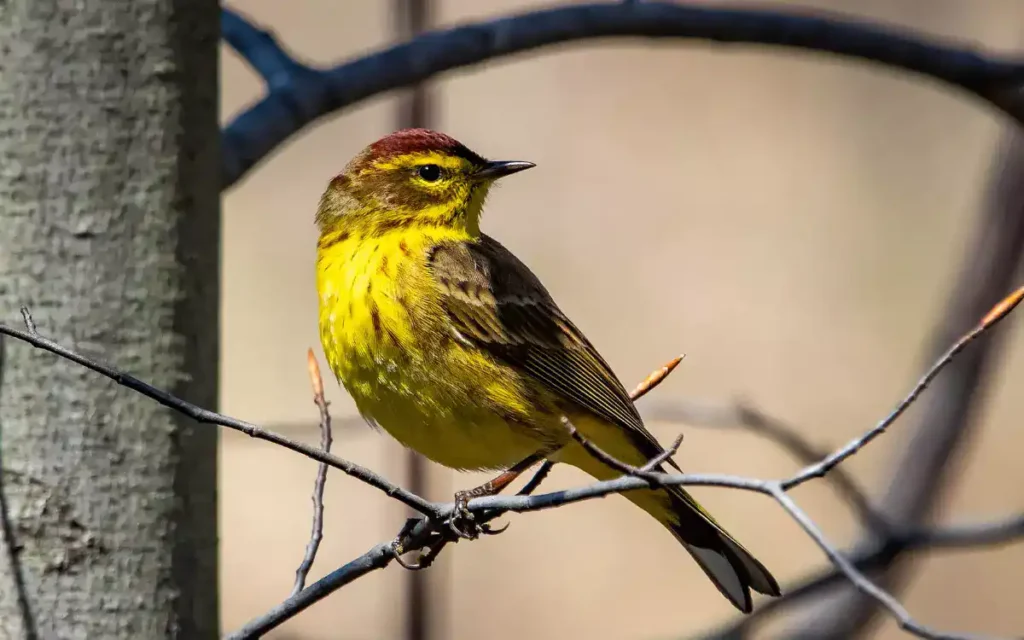
With its constant tail-wagging movement, the Palm Warbler adds an element of animation to West Virginia’s habitats. Its yellow underparts and rusty cap make it easy to spot.
These birds often choose to nest on the ground, laying around 4 to 5 eggs in well-hidden locations. As they pass through the state during migration, they offer a fleeting yet memorable presence.
- Length: 4.7-5.5 in (12-14 cm)
- Weight: 0.3-0.5 oz (7-13 g)
- Wingspan: 7.9-8.3 in (20-21 cm)
11. Blue-winged Warbler – Vermivora cyanoptera:
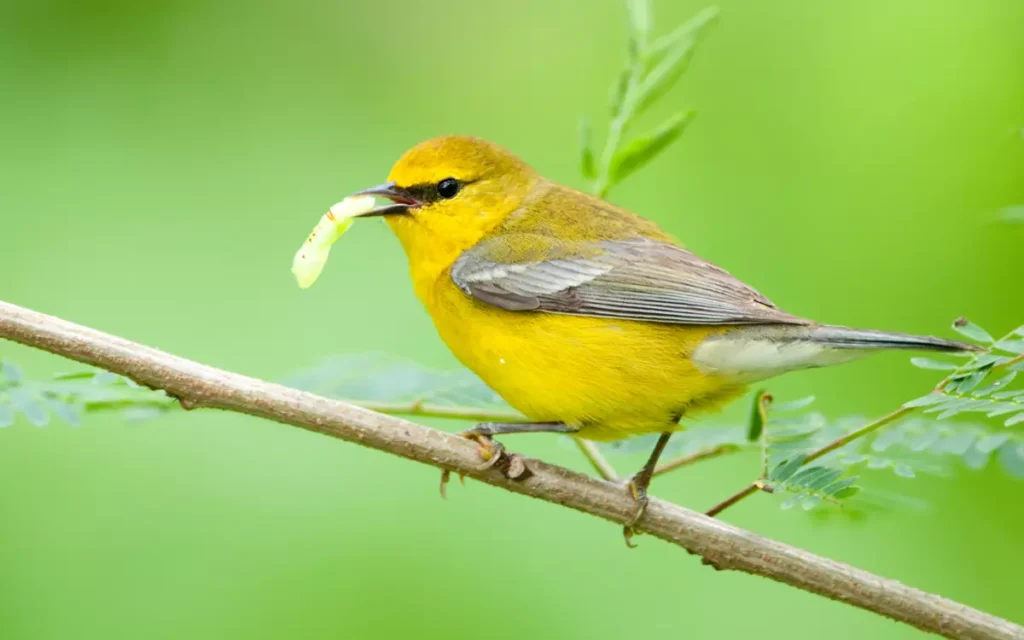
The Blue-winged Warbler boasts a striking combination of yellow and blue-gray tones, creating a visual masterpiece. It’s often found in open woodlands and shrubby areas.
Nesting in low shrubs, females lay 3 to 7 eggs in cup nests. Their distinctive buzzy songs and vibrant appearance make them a beloved addition to West Virginia’s birdlife.
- Length: 4.75 inches (12 cm)
- Weight: around 0.3 oz (9 g)
- Wingspan: 6.75 – 7.5 inches (17 – 19 cm)
12. Magnolia Warbler – Setophaga magnolia:
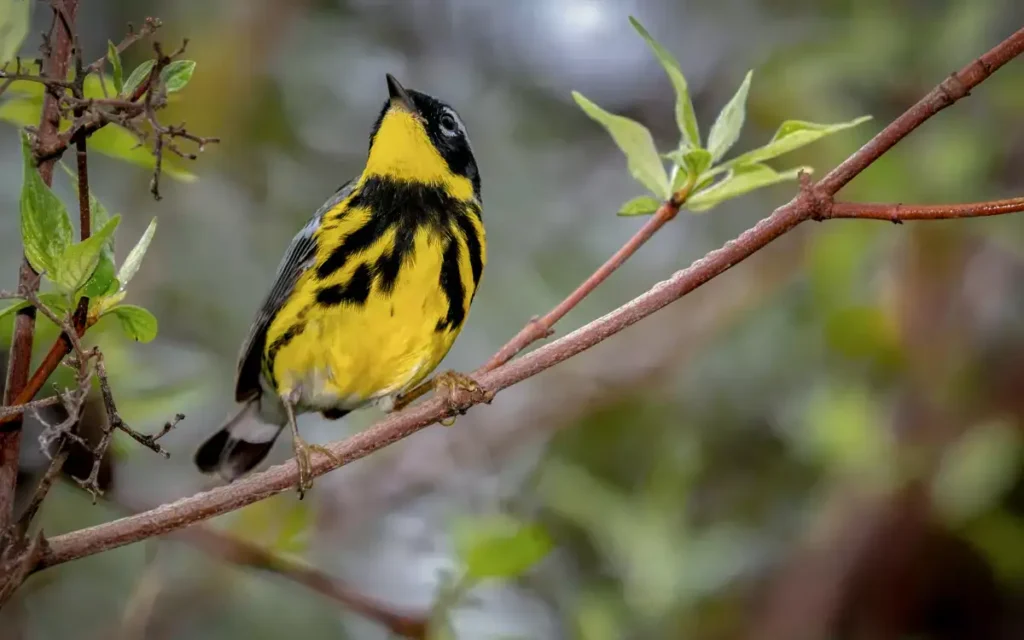
The Magnolia Warbler is a true gem with its striking black necklace and bright yellow underparts. It graces West Virginia’s woodlands and forests during migration, adding a burst of color to the canopy.
Female Magnolia Warblers lay around 4 to 5 eggs in cup nests, ensuring the continuation of their species. Their beauty and charm capture the essence of the state’s avian diversity.
- Length: 4.3-5.1 in (11-13 cm)
- Weight: 0.2-0.5 oz (6-15 g)
- Wingspan: 6.3-7.9 in (16-20 cm)
13. Yellow-throated Vireo – Vireo flavifrons:
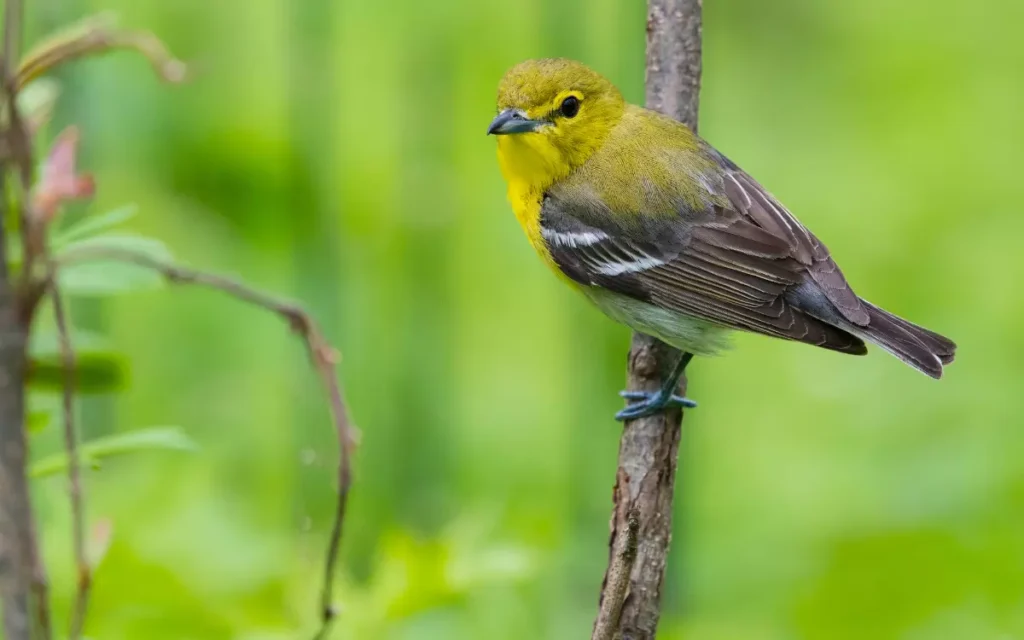
The Yellow-throated Vireo, with its distinctive lemon-colored throat, graces the forests of West Virginia with its melodious songs.
This small migratory bird, known for its cup-shaped nests, lays an average of 3 to 4 eggs in a clutch. During its stay in West Virginia, which spans from spring to early fall, it actively participates in raising its hatchlings.
- Length: 5.1-5.9 in (13-15 cm)
- Weight: 0.5-0.7 oz (15-21 g)
- Wingspan: 9.1 in (23 cm)
14. Yellow-throated Warbler – Setophaga dominica:
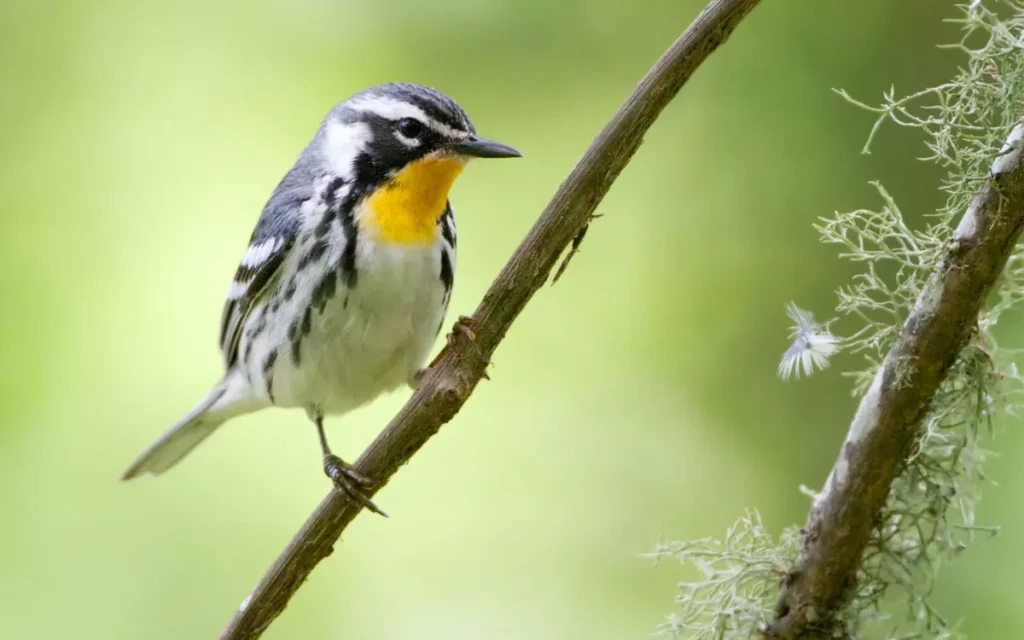
The Yellow-throated Warbler, a charismatic songbird, is a sight to behold with its bright yellow plumage and striking black markings.
These warblers construct their nests in the branches of tall trees, skillfully camouflaging them. With a typical clutch size of 3 to 4 eggs, these birds invest their summers in nurturing their young ones before embarking on their migratory journey.
- Length: 5.1-5.5 in (13-14 cm)
- Weight: 0.3-0.4 oz (9-11 g)
- Wingspan: 8.3 in (21 cm)
15. Hooded Warbler – Setophaga citrina:
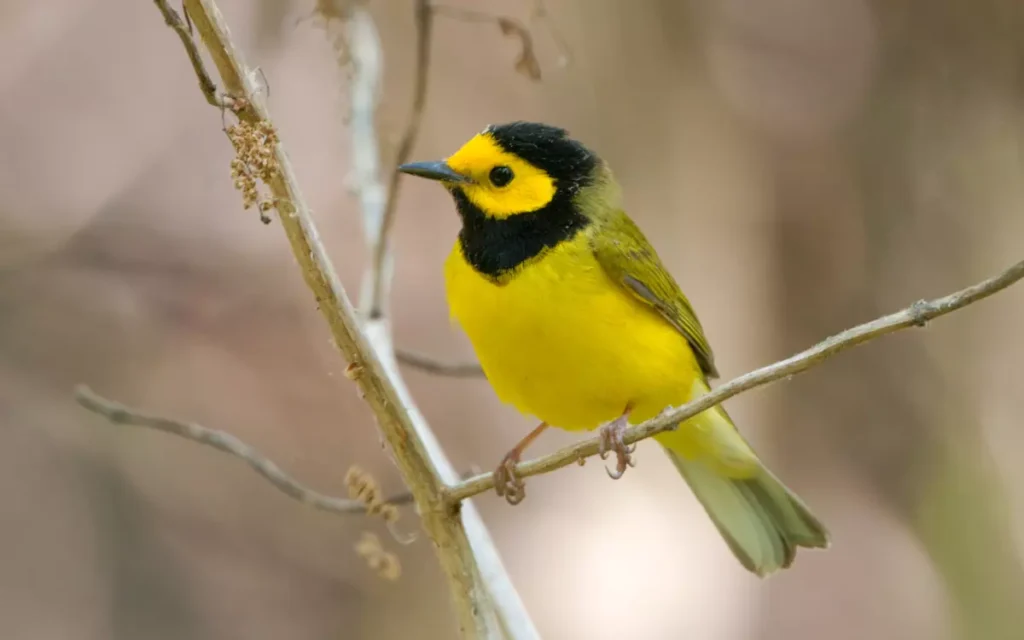
The Hooded Warbler, adorned with its yellow hood and olive-green back, brings a touch of elegance to West Virginia’s wooded areas.
These birds are known for laying 3 to 5 eggs in their nests, which are often tucked away in the underbrush. Their charming presence during the breeding season enhances the state’s biodiversity.
- Length: 5.1 in (13 cm)
- Weight: 0.3-0.4 oz (9-12 g)
- Wingspan: 6.9 in (17.5 cm)
16. Eastern Meadowlark – Sturnella magna:
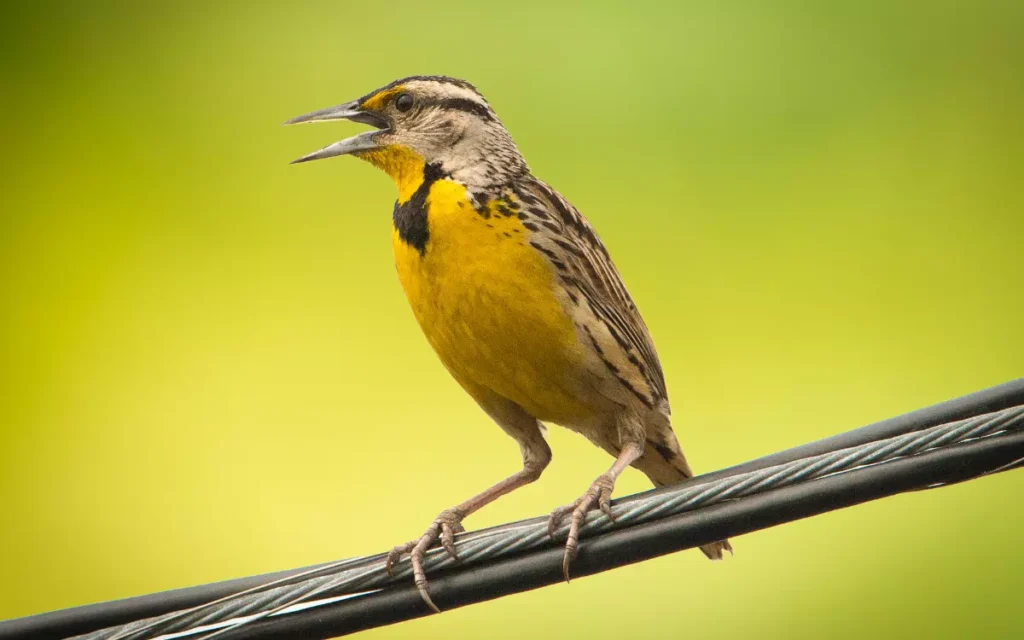
The Eastern Meadowlark’s vibrant yellow breast sets it apart as an emblem of open grasslands and meadows.
With a unique song that resonates across its habitat, these birds lay around 2 to 7 eggs in their nests. Throughout the year, they grace West Virginia’s plains with their distinct presence.
- Length: 7.5-10.2 in (19-26 cm)
- Weight: 3.2-5.3 oz (90-150 g)
- Wingspan: 13.8-15.8 in (35-40 cm)
17. Black-throated Green Warbler – Setophaga virens:
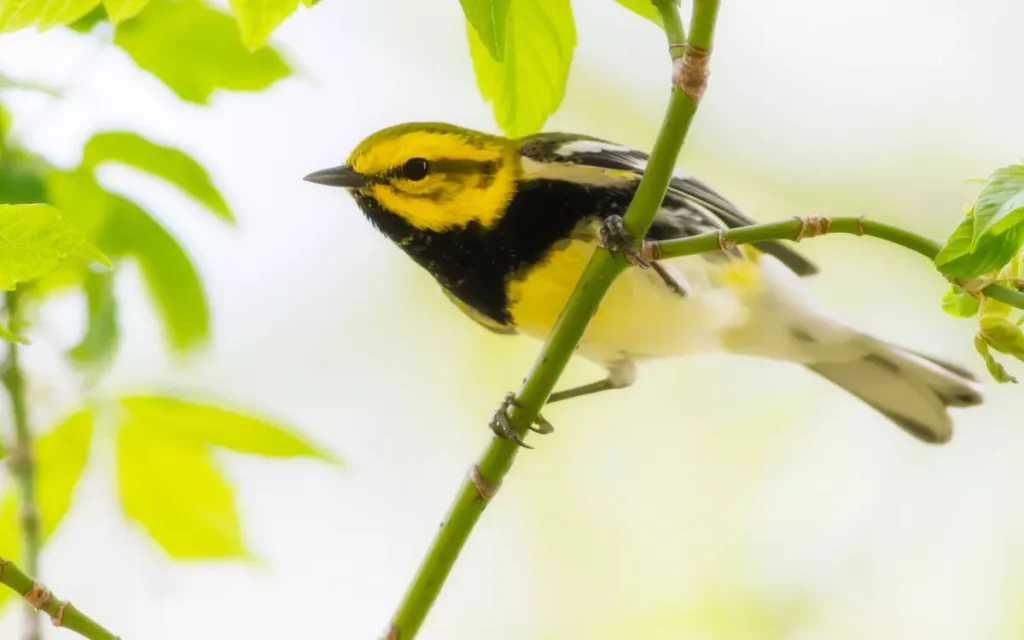
The Black-throated Green Warbler boasts a black throat and vibrant yellow plumage, adding charm to West Virginia’s coniferous forests.
These warblers build cup-shaped nests and typically lay 3 to 5 eggs. Their summer stay in the state coincides with the lush greenery, creating picturesque landscapes.
- Length: 4.3-4.7 in (11-12 cm)
- Weight: 0.3-0.4 oz (7-11 g)
- Wingspan: 6.7-7.9 in (17-20 cm)
18. Common Yellowthroat – Geothlypis trichas:
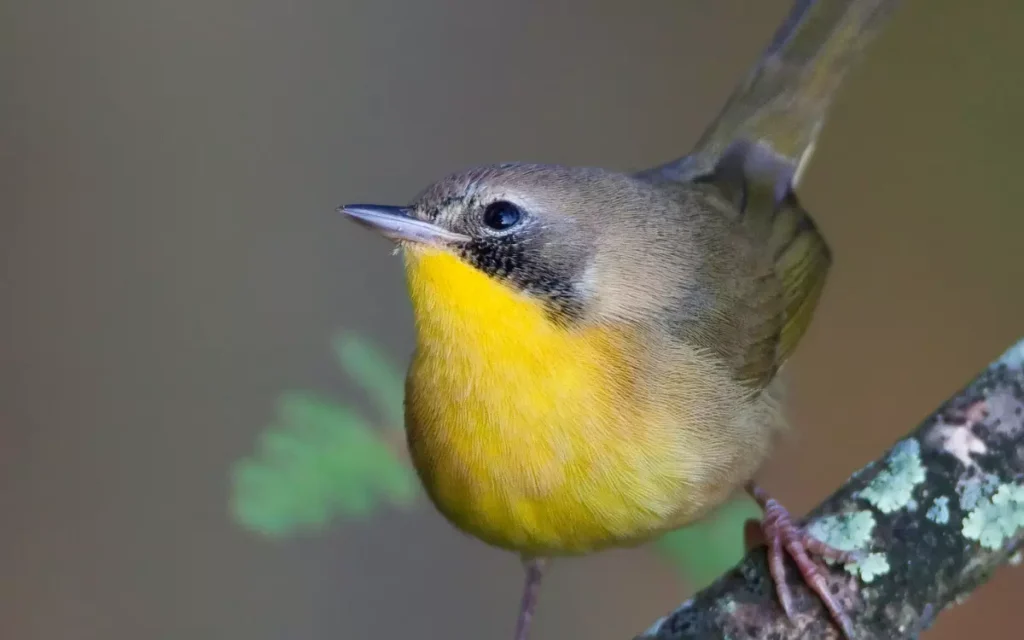
The Common Yellowthroat’s distinctive mask-like markings and bright yellow underparts make it a recognizable presence in marshy habitats. These birds lay 3 to 5 eggs in their nests,
strategically hidden among the wetland vegetation. Their annual visit enriches West Virginia’s wetland ecosystems.
- Length: 4.3-5.1 in (11-13 cm)
- Weight: 0.3-0.3 oz (9-10 g)
- Wingspan: 5.9-7.5 in (15-19 cm)
19. American Goldfinch – Spinus tristis:
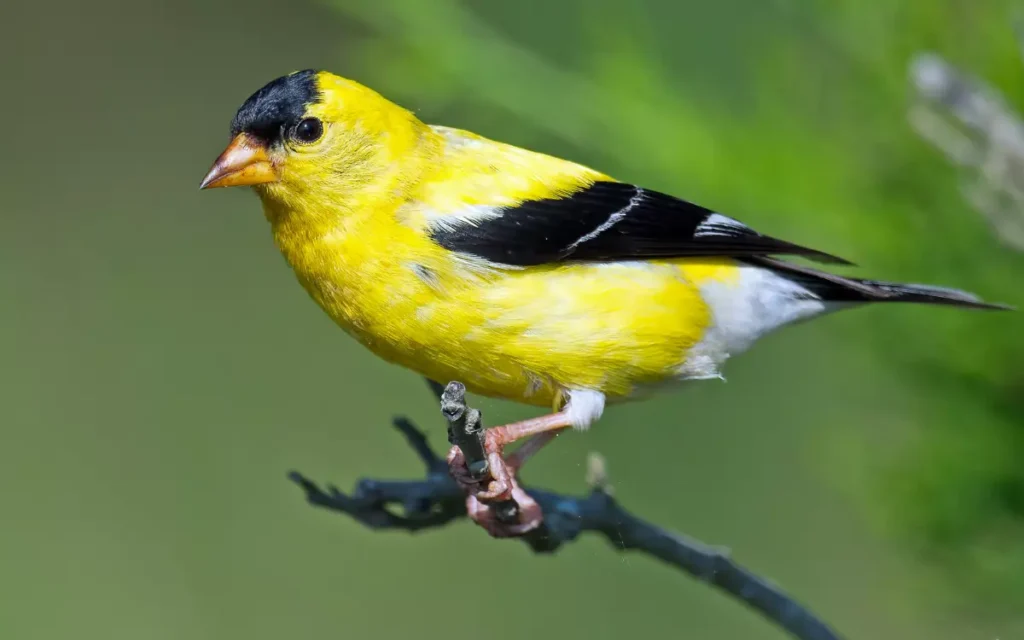
The American Goldfinch, donning its bright yellow summer plumage, epitomizes the spirit of sunny days. These finches construct intricate nests and lay an average of 3 to 4 eggs.
Their presence throughout the year, including the colder months, showcases their ability to adapt to West Virginia’s changing seasons.
- Length: 4.3-5.1 in (11-13 cm)
- Weight: 0.4-0.7 oz (11-20 g)
- Wingspan: 7.5-8.7 in (19-22 cm)
20. Cedar Waxwing – Bombycilla cedrorum:
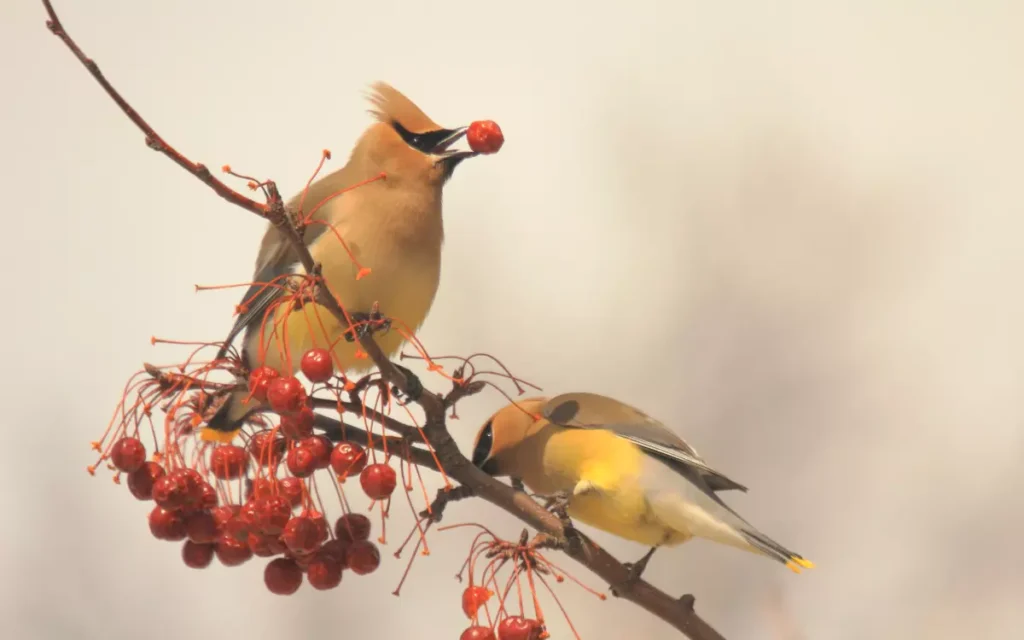
The Cedar Waxwing’s subtle blend of yellow and gray, coupled with its distinctive crested head, adds an element of sophistication to the state’s avian residents.
These birds are known to lay around 2 to 6 eggs in their nests. Their sporadic visits throughout the year bring an air of unpredictability to West Virginia’s birdwatching opportunities.
- Length: 5.5-6.7 in (14-17 cm)
- Weight: 1.1 oz (32 g)
- Wingspan: 8.7-11.8 in (22-30 cm)
FAQs
Q: What’s the significance of birdwatching in West Virginia?
A: Birdwatching in West Virginia offers not only an opportunity to observe stunning avian species but also a chance to connect with nature and contribute to conservation efforts.
Q: Are these colorful birds year-round residents?
A: While some of these birds are year-round residents, others are migratory and may only be seen during specific seasons.
Q: Can I attract these birds to my backyard?
A: Yes, creating a bird-friendly environment with feeders, water sources, and appropriate plants can attract these colorful birds to your backyard.
Q: How can I differentiate between similar-looking species?
A: Pay attention to specific features such as bill shape, size, and distinctive markings to differentiate between similar species.
Q: Can I find these birds in urban areas?
A: Yes, many of these birds have adapted to urban environments, making them accessible even in city settings.
Q: What’s the best time of day to spot these colorful birds?
A: Early morning and late afternoon are ideal times to observe these birds, as they are often more active during these periods.
Conclusion:
Investigating the Red, Orange & Yellow Birds of West Virginia offers a special way to enjoy nature. These birds add beautiful colors to our forests and atmospheres. Get outside and start birdwatching to see them for yourself!

